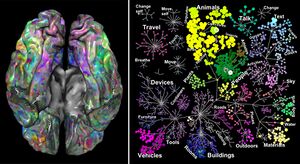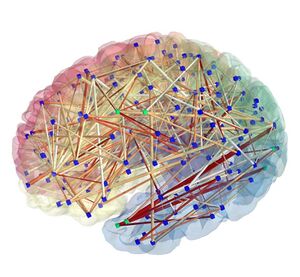Visual effects - Psychedelics
This article attempts to break down the visual effects contained within the psychedelic experience into simple, easy to understand titles, descriptions and levelling systems. This is done without depending on metaphors, analogies or personal trip reports. The article starts off with descriptions of the simpler effects and works its way up towards more complex experiences as it progresses.
Enhancements
Colour enhancement
Color enhancement is defined as an intensification of the brightness and vividness of colors in the external environment. During this experience, reds may seem “redder”, greens may seem “greener", and all colors will likely appear much more distinct, complex, and visually intense than they comparatively would be during everyday sober living.[1][2][3][4][5][6][7] At higher levels, this effect can sometimes result in seeing colors which are perceived as surreal or seemingly impossible.[3][4]
Color enhancement is often accompanied by other coinciding effects such as visual acuity enhancement and pattern recognition enhancement.[1][2] It is most commonly induced under the influence of mild dosages of psychedelic compounds, such as LSD, psilocybin, and mescaline. However, it can also occur to a lesser extent under the influence of certain stimulants and dissociatives such as MDMA, ketamine[8], or 3-MeO-PCP.
Image examples
| Caption | |
|---|---|
 | Japanese Garden by Anonymous |
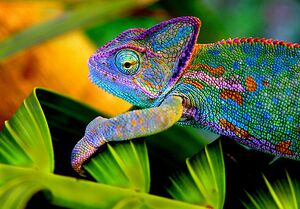 | Chameleon by Anonymous. |
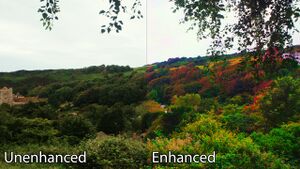 | Showing differences by Chelsea Morgan |
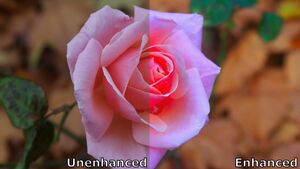 | Rose by Chelsea Morgan |
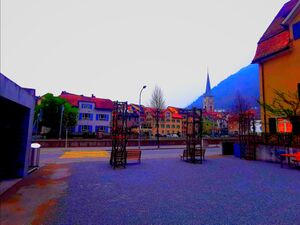 | Chur, Switzerland by Naps284 |
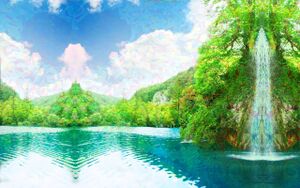 | Paradise island by Subsentience |
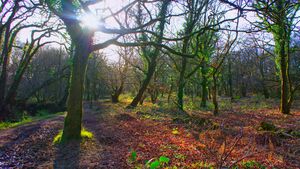 | The Woods by Chelsea Morgan |
Magnification
Magnification (also known as macropsia or megalopsia[9]) is defined as the experience of distant details within one's visual field appearing closer and more "zoomed in" than they actually are due to both visual enhancements and hallucinatory effects.[10] This can give the perception that one is seeing objects from greater distances than is usually possible within everyday life.
At its lower levels, this can allow people to see nearby objects (such as within reaching distance) as much closer than they really are, resulting in the perception that their visual capabilities have been enhanced.[10] At its higher levels, this can induce the perception of seeing distant objects as if they were right in front of the user despite their distance. These distances can range from several feet to hundreds of meters. Since this is most likely a physiological impossibility, it suggests that higher level magnification may actually be a seamless hallucinatory state in which the details of distant visual input are predictively simulated in a realistic and convincing manner.
It's worth noting that this effect is considerably more likely to occur if a person spends extended periods of time staring at an object or scene within the distance.
Magnification is often accompanied by other coinciding effects such as visual acuity enhancement and pattern recognition enhancement. It is a rare effect that is most commonly induced under the influence of moderate dosages of psychedelic compounds, such as LSD, psilocybin, and mescaline.
Pattern recognition enhancement
Pattern recognition enhancement is defined as an increase in a person's ability and tendency to recognize patterns within vague stimuli.
Seeing patterns resemble human faces is an innate ability which humans possess in everyday life and is well documented in scientific literature under the term pareidolia.[11][12] Common examples of this include spotting faces in the front of a car, or seeing different objects in clouds.[6]
During this effect, patterns can be significantly more pronounced than it would usually be during a sober state.[13][14] For example, remarkably detailed images may appear embedded in scenery, everyday objects may look like faces, and clouds may appear as fantastical objects all without any visual alterations taking place. Once an image has been perceived within an object or landscape, the mind may further exaggerate this recognition through the hallucinatory effect known as transformations, which goes beyond pareidolia and becomes a standard visual hallucination.
Pattern recognition enhancement is often accompanied by other coinciding effects such as visual acuity enhancement and colour enhancement.[1][2] It is most commonly induced under the influence of mild dosages of psychedelic compounds, such as LSD, psilocybin, and mescaline.
Image examples
| Caption | |
|---|---|
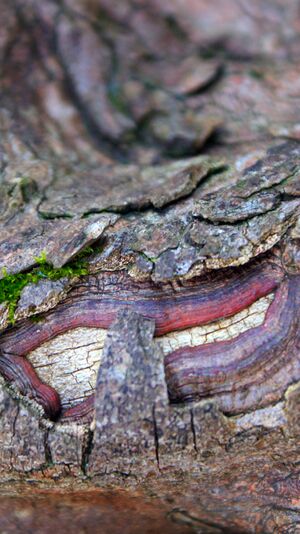 | Smile in tree bark by Chelsea Morgan |
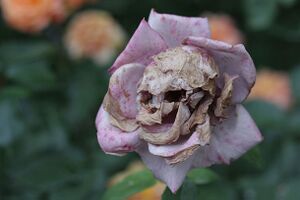 | Skullflower by Anonymous |
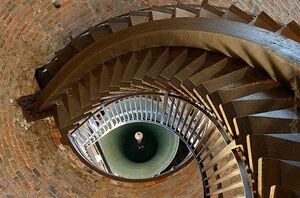 | Eye of the tower by Davide Lombardi |
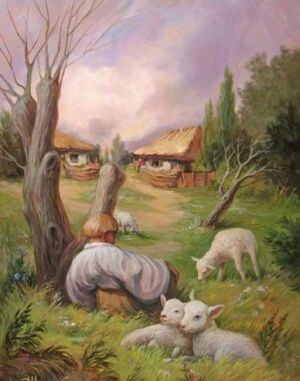 | Optical illusion by Oleg Shuplyak |
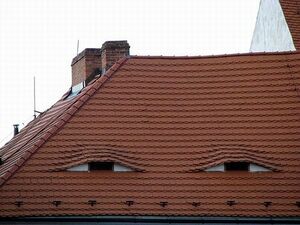 | Squinting eyes on a roof top by Anonymous |
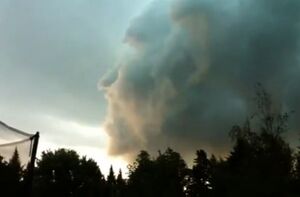 | Face within a cloud by Denis Farmer |
 | Face in a cloud by Neil Usher |
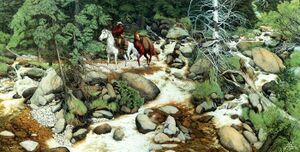 | The Forest Has Eyes by Bev Doolittle |
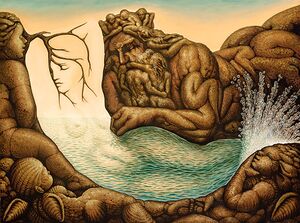 | Absents of the mermaid by Octavio Ocampo |
 | Face within tree bark by Bev Doolittle |
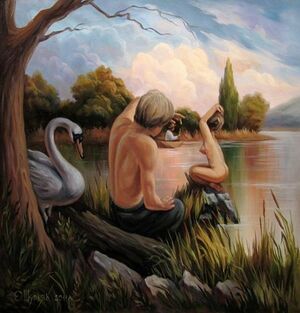 | Optical illusion by Oleg Shuplyak |
Acuity enhancement
Visual acuity enhancement is defined as a heightening of the clearness and clarity of vision. This results in the visual details of the external environment becoming sharpened to the point where the edges of objects become perceived as extremely focused, clear, and defined. The experience of this acuity enhancement can be likened to bringing a camera or projector lens that was slightly blurry into focus. At its highest level, a person may experience the ability to observe and comprehend their entire visual field simultaneously, including their peripheral vision. This is in contrast to the default sober state where a person is only able to perceive the small area of central vision in detail.[15]
While under the influence of this effect, it is common for people to suddenly notice patterns and details in the environment they may have never previously noticed or appreciated. For example, the complexity and perceived beauty of the visual input often become apparent when looking at sceneries, nature, and everyday textures.
Visual acuity enhancement is often accompanied by other coinciding effects such as color enhancement and pattern recognition enhancement.[1][2] It is most commonly induced under the influence of mild dosages of psychedelic compounds, such as LSD, psilocybin, and mescaline. However, it can also occur to a lesser extent under the influence of certain stimulants and dissociatives such as MDMA or 3-MeO-PCP.
Image examples
| Caption | |
|---|---|
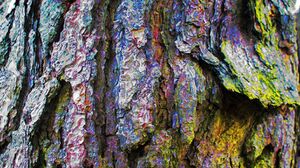 | Tree Bark by Chelsea Morgan |
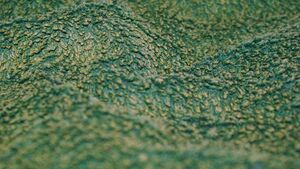 | Towel by Chelsea Morgan |
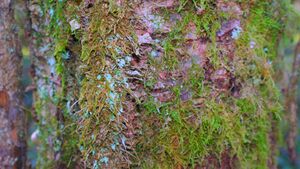 | Moss on tree Bark by Chelsea Morgan |
Distortions
After images
After images (also known as palinopsia) are defined as visual perceptions which continue to appear in one's vision after exposure to the original image has ceased.[4][6][16] A common form of after image is the bright glow that seems to float in one's vision after looking into a light source for a few seconds. This effect is similar to tracers, but differs in that it does not create smooth blurs behind moving objects.
During hallucinogenic experiences, moving objects can produce a trail of overlayed, still images behind their path of motion.[6][1][17][18][19][20] This creates a series of overlayed images of a moving object across one's visual field which become more faded the longer the duration since the object occupied that location in space. Another common manifestation of this effect is being able to see a residual image of the external environment for several seconds after one closes their eyes before it gradually fades away.
After images are often accompanied by other coinciding effects such as tracers[17][21][22] and drifting.[1] They are most commonly induced under the influence of moderate dosages of psychedelic compounds, such as LSD, psilocybin, and mescaline.[23] However, trailing effects have also been experienced with other drugs of a very different pharmacology, such as GABA potentiators.[19]
Colour replacement
Color replacement is defined as the experience of a person's entire visual field or specific objects and sections within it becoming replaced with an alternative color which differs from its original appearance.[4] For example, the person's vision could become tinted purple, the green leaves of a tree could become red, or a black car could become white.
Although similar, this component differs from color shifting as it is a static change in color which remains still and semi-permanent as opposed to constantly cycling between various hues, tints and shades.
Color replacement is often accompanied by other coinciding effects such as color enhancement and color shifting. It is most commonly induced under the influence of moderate dosages of psychedelic compounds, such as LSD, psilocybin, and mescaline.
Diffraction
Diffraction is defined as the experience of seeing rainbows and spectrums of colour embedded within the brighter parts of a person's visual field. This visual effect is likely due to pupil dilation resulting in some light sources hitting the lens of the eye in a manner which appears to spread into a larger range of the spectrum rather than a consolidated wavelength.[citation needed]
Diffraction is most commonly induced under the influence of mild dosages of psychedelic compounds, such as LSD, psilocybin, and mescaline. However, this effect is also experienced during everyday sober living for certain people.
Image examples
| Caption | |
|---|---|
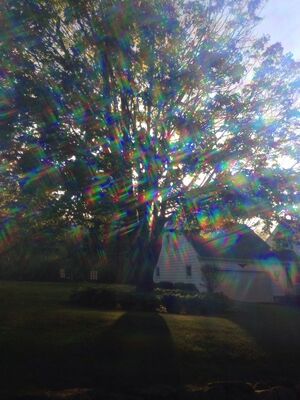 | Diffraction Shades by capture-life-with-lens.tumblr.com |
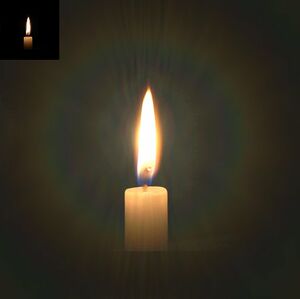 | Glare by Anonymous |
Perspective distortions
A perspective distortion is defined as a subtle to extreme change in how a person perceives the size and distance attributed their body, to specific parts of the external environment, or to the external environment as a whole.[24]
This effect is capable of manifesting itself in 4 different ways which may reflect the failure of each respective responsible visual function.[25]
- Size distortions:
When affecting distance, perspective distortions can make things seem as if they are physically closer or further away than they usually would be. This can range from a subtle experience, such as the other side of the room feeling marginally further away than it usually would be, to an extreme experience, such as feeling as if the horizon is right in front of you.
When affecting size, perspective distortions can make things seem as if they are physically smaller or larger in terms of the sense of size that one would usually attribute to them.[6][30][31] This can range from a subtle experience, such as the room feeling marginally smaller and more cramped than it usually would be, to an extreme experience, such as feeling as if the room is hundreds of miles wide.
Perspective distortions are often accompanied by other coinciding effects such as depth perception distortions and visual disconnection. They are most commonly induced under the influence of moderate dosages of dissociative compounds, such as ketamine, PCP, MXE, and DXM.
Alice in Wonderland Syndrome
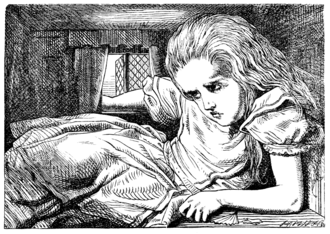
Alice in Wonderland Syndrome (AIWS) is characterized by macropsia, micropsia, pelopsia, teleopsia, altered perception of shape (meta-morphopsia), and time distortion.[32]
Feelings of suddenly having an impossibly giant or tiny body are also a very common manifestation of this effect. This feeling is already known by the scientific literature as “Alice in Wonderland Syndrome”, where it is seen as a temporary condition often associated with migraines, brain tumours, and the use of psychoactive drugs.[24][33] The effect can either be attributed to the body as a whole or specific parts of it. For example, feelings of having a huge head or tiny limbs are possible.
Recursion

Recursion is defined as a visual distortion which partially to completely alters the appearance of one's external environment by repeating specific sections of itself across itself in a self-similar fashion. It results in the appearance of fractal-like patterns which often zoom into or away from the original image. This effect typically occurs spontaneously and rarely sustains itself for more than several seconds.
Recursion is most commonly induced under the influence of moderate dosages of psychedelic compounds, such as LSD, psilocybin, and mescaline.
Image examples
| Caption | |
|---|---|
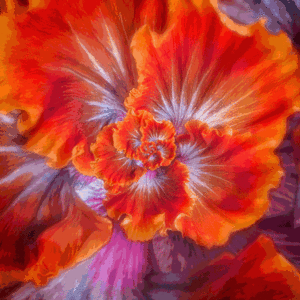 | Recursion by Giphy |
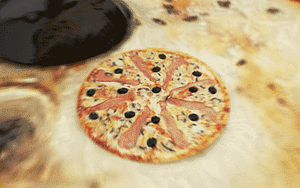 | Recursion by Tumblr |
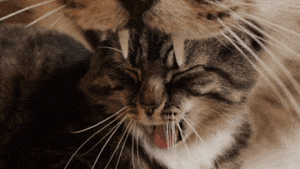 | Recursion by PandaWhale.com |
 | Recursion by GifBin |
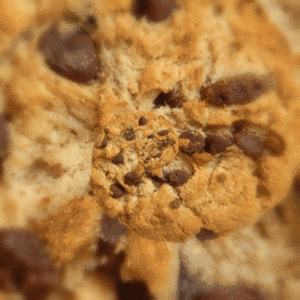 | Recursion by Giphy |
 | Recursion by Giphy |
Colour shifting
Color shifting is defined as the experience of various objects within the external environment shift and change their color through a continuously repeating cycle that occurs in a fluid motion across the surface of the object.[4] For example, moss on a rock could visibly shift from green to red to blue to any other color and then back to green again in the style of a smooth and seamless animated loop. This effect is particularly strong and likely to occur if the objects original color was bright or out of place.
Color shifting is often accompanied by other coinciding effects such as color enhancement and color replacement. It is most commonly induced under the influence of moderate dosages of psychedelic compounds, such as LSD, psilocybin, and mescaline. However, it can also occur to a lesser extent under the influence of certain entactogens such as MDMA, MDA, and 6-APB.
Image examples
| Caption | |
|---|---|
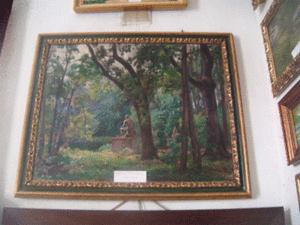 | Painting by Anonymous |
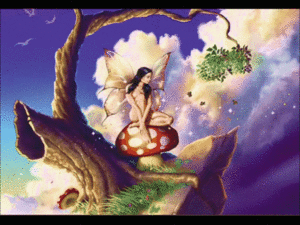 | Lucy the Fairy by StingrayZ |
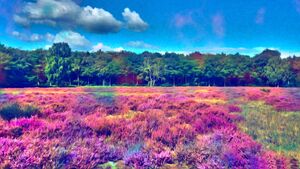 | Field by Anonymous |
 | Japanese Maple by Anonymous |
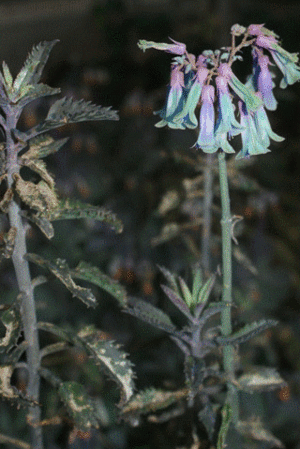 | Flowers by Chelsea Morgan |
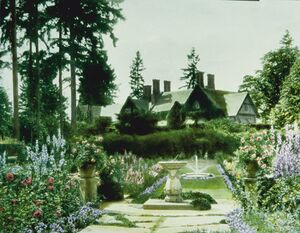 | Garden painting by Anonymous |
Drifting
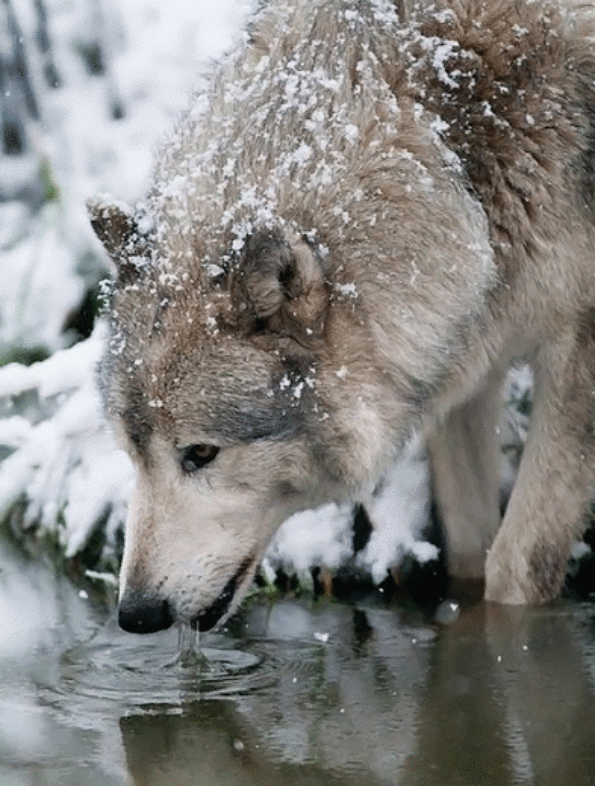
Drifting is defined as the experience of the texture, shape, and general structure of objects and scenery appearing progressively warped, melted, and morphed across themselves.[2][4][34] These alterations gradually increase in intensity as a person stares, but are temporary and will reset to their normal appearance the moment a person double takes.
This effect is capable of manifesting itself across the 4 different levels of intensity described below:
- Peripheral - At the lowest level, visual drifting can be described as a wiggling of straight lines within the external environment. This occurs exclusively within a person's peripheral vision and cannot be directly looked at.
- Direct - At this level, visual drifting does not necessarily increase in intensity, but can now be directly looked at within a person's central line of sight. This partially alters the appearance and form of shapes, objects, and sceneries within the external environment, causing them to subtly drift, bend, and morph.
- Distinct - At this level, visual drifting becomes powerful enough to drastically alter and transform the shape of specific objects within a person's external environment. If one stares at a fixed point and keeps their eyes relatively motionless, the effect can be powerful enough to render objects progressively unrecognizable from their original form.
- All-encompassing - At the highest level of visual drifting, the intensity becomes powerful enough to distort not just specific objects, but every single point of a person's vision and the entirety of the external environment. This creates the appearance of an extremely smudged, warped, and blended mass of unrecognisable visual data.
Drifting is often accompanied by other coinciding effects such as symmetrical texture repetition and tracers.[2][1] It is most commonly induced under the influence of moderate dosages of psychedelic compounds, such as LSD, psilocybin, and mescaline. However, it can also occur to a lesser extent under the influence of certain stimulants and dissociatives such as MDMA or 3-MeO-PCP.
The particular style of this visual effect depends on the specific continuously changing direction, speed, and rhythm of the distortion. This results in a small variety of different manifestations which are defined and listed below:
Morphing
Morphing can be described as a style of visual drifting which is completely disorganised and spontaneous in both its rhythm and direction. It results in objects and scenery appearing to change gradually, morph, and warp in their size, shape, and configuration.
Breathing
Breathing can be described as a style of visual drifting which results in objects and scenery appearing to steadily contract inwards and expand outwards in a consistent rhythm, similar to the lungs of a living organism.
Melting
Melting can be described as a style of visual drifting which results in the texture of objects and scenery appearing to completely or partially melt. It begins at lower intensities as a gradual distortion of an object's texture which causes them to subtly droop, wobble, and lose their structural integrity. This gradually increases until it becomes impossible to ignore as the lines, textures, and colour between solid objects melt into one another in an extremely fluid style.
Flowing
Flowing can be described as a style of visual drifting which seems to occur almost exclusively on textures (particularly if they are highly detailed, complex, or rough in appearance). It results in the textures appearing to flow like a river in a seamless, looped animation. It is particularly common on wood grain or the fur of animals.
Image examples
| Caption | |
|---|---|
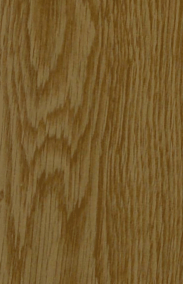 | Breathing wooden post by Chelsea Morgan |
 | Mobile phone by Chelsea Morgan |
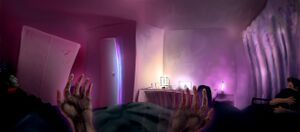 | Visual drifting by Anonymous |
 | Breathing wooden post by Anonymous |
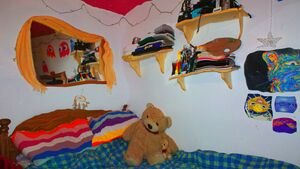 | Wibbly Wobbly Bedroom by Chelsea Morgan |
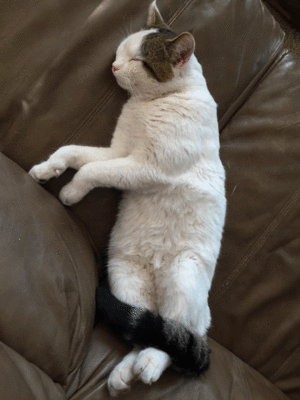 | Drifting Cat by Anonymous |
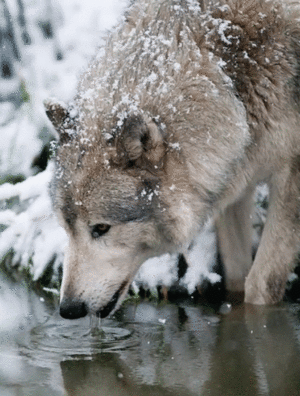 | White Wolf Drinking Water by Anonymous |
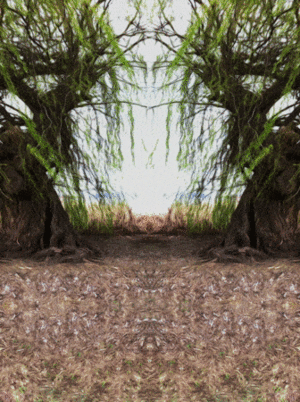 | Symmetric drifting patterns by Anonymous |
 | Drifting gun by Anonymous |
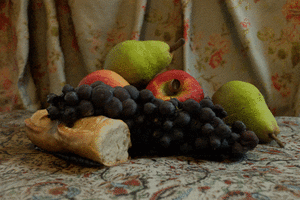 | Flowing fruit by Anonymous |
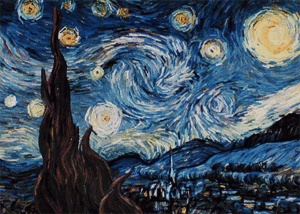 | The Starry Night by Vincent Van Gogh |
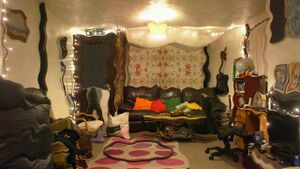 | Living room by Chelsea Morgan |
 | Lucy the Fairy by StingrayZ |
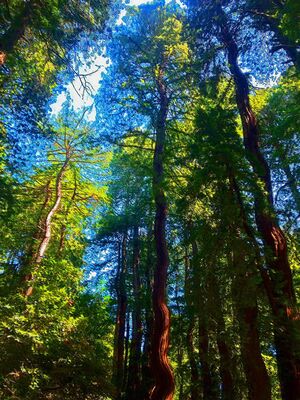 | Redwoods by CountRoloff |
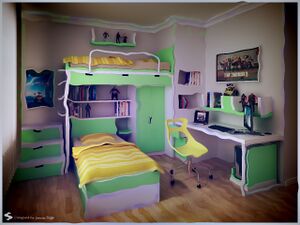 | Drifting by Anonymous |
Variations
The specific differences between each potential style of drifting can be broken down into the following variations and may occur independent of effect intensity:
- Intricate vs. Simplistic – Drifting can alter the external environment in a way that spreads out in many different complex directions and results in the original piece of sensory input becoming completely unrecognisable in appearance. Alternately, it can be simplistic in nature consisting of simple warping, wiggling and bending even at high dosages of psychoactive substances.
- Slow vs. Fast – Drifting can manifest as alterations that progress at a sudden rate and produce fast movement in the visual field or it can manifest gradually and move slowly as a person stares into it.
- Smooth vs. Jittery – Drifting can manifest as a smooth, fluid, and seamless movement or it can manifest as jittery with an extremely slow frame rate that moves in sudden and partial transitions.
- Static vs. Fleeting – Drifting can either freeze in its distorted position until one performs a double take or can be extremely fleeting in nature, resetting almost as soon as a person tries to look directly at it.
- Realistic vs. Unrealistic – Drifting can either look convincingly natural and life-like in its appearance and motion or can look extremely cartoon-like, exaggerated and unrealistic. </onlyinclude>
Psychoactive substances
Compounds within our psychoactive substance index which may cause this effect include:
- 1B-LSD
- 1P-ETH-LAD
- 1P-LSD
- 1V-LSD
- 1cP-AL-LAD
- 1cP-LSD
- 1cP-MiPLA
- 2-FEA
- 2-FMA
- 25B-NBOH
- 25B-NBOMe
- 25C-NBOH
- 25C-NBOMe
- 25D-NBOMe
- 25E-NBOH
- 25I-NBOH
- 25I-NBOMe
- 25N-NBOMe
- 2C-B
- 2C-B-FLY
- 2C-C
- 2C-D
- 2C-E
- 2C-I
- 2C-P
- 2C-T
- 2C-T-2
- 2C-T-21
- 2C-T-7
- 3,4-CTMP
- 3C-E
- 3C-P
- 4-AcO-DET
- 4-AcO-DMT
- 4-AcO-DiPT
- 4-AcO-MET
- 4-AcO-MiPT
- 4-HO-DET
- 4-HO-DPT
- 4-HO-DiPT
- 4-HO-EPT
- 4-HO-MET
- 4-HO-MPT
- 4-HO-MiPT
- 5-Hydroxytryptophan
- 5-MeO-DALT
- 5-MeO-DMT
- 5-MeO-DiBF
- 5-MeO-DiPT
- 5-MeO-MiPT
Experience reports
Anecdotal reports which describe this effect within our experience index include:
- Experience: 15mg 2C-B (oral) - A pleasant low-dose evening with Nexus
- Experience: 18 mg 2C-I - Visually intense and strong bodily sensations
- Experience: 22mg 2C-B (oral) / 100ug 1P-LSD (sublingual) - My first time tripping alone (2 days in a row)
- Experience: 25mg 2C-E (oral) - A mindblowing experience
- Experience: 300mg DXM (Oral) - Brink of the third
- Experience: 32mg 2C-B - Bromo Mescaline
- Experience: 36mg 4-AcO-DiPT - Truly, one for the psychedelic animals among us
- Experience: 450 Datura seeds - Talking to Ghosts
- Experience: 5-EAPB (60mg) + 2-FMA (20mg) + 4-AcO-DMT (10mg) - Emotional catharsis
- Experience: 80mg EPT - Bummer
- Experience: 80mg EPT - Slight improvement
- Experience: LSD (Unknown dosage) - My experiences with LSD and anorexia/bulemia
- Experience:1000 Morning Glory seeds - Rediscovering the Self
- Experience:100ug 1P-LSD - A Fear and loathing into Bliss
- Experience:1050 µg 1cP-LSD - The matrix
- Experience:1064mgs - Fascinating DXM experience - Unusual effects
- Experience:120mg - Garden of The Gods
- Experience:120µg LSD - First Bad Acid Trip, Psychosis
- Experience:150mg MDMA + 20mg 2C-B - I designed it this way myself
- Experience:170mg 4-AcO-DMT - Recklessness rewarded
- Experience:1mg 25c-NBOMe - Experiment in my room
- Experience:2 grams Psilocybe Cubensis + 2.7 grams Syrian Rue - The Psilohuasca Albino Fox
- Experience:2 hits of LSD + weed - Mindfuck
- Experience:2 x 150 LSD tabs
- Experience:2.5g - Swim's first mushroom trip
- Experience:2.5g Mushrooms + 500mg DMT
- Experience:2.5g Peganum Harmala + 250µg LSD - Ecstasy of Love and Misanthropy
- Experience:2.5g Syrian rue + 6g Mimosa Hostilis - Becoming God (my second experience with unity)
- Experience:20x Extract - a tall humanoid figure wearing a white cloak
- Experience:225ug - Sheer Awe and Joy
- Experience:225ug LSD + 9g cubensis - Galactic Melt and the Meverse
- Experience:250 seeds - Harsh body load
- Experience:250mg MDA / 250mg MDMA - unnecessarily large dosage
- Experience:25mg (insufflated) - Simultaneously amazing and horrible
- Experience:25mg Quetiapine - Nice buzz
- Experience:2g Syrian rue + 1g Mimosa Hostilis - These voices are the building blocks of consciousness
- Experience:2mg 25C-NBOMe - Experimental trip to test personal limits of NBOMes
- Experience:3 drops of cinnamon bark oil/ 5 drops of german chamomile oil/ 2mL of nutmeg oil in lecithin - experiments with nutmeg oil
- Experience:3.5g Syrian rue + 30g Mimosa Hostilis brew - flying through a rainbow tunnel
- Experience:3.5g psilocybe cubensis - Relinquishing of Material Chains/Fear and Desolation
- Experience:300µg AL-LAD - Don't worry, because you're everyone!
- Experience:300µg LSD - Togetherness and the Silent Dusk
- Experience:30mg (smoked) DMT - The Monolith
- Experience:30mg - Horrible bodyload
- Experience:30mg - Psychostimulant egodeath
- Experience:30mg 4-HO-MiPT - Positively groovy
- Experience:337mg DMT fumarate - A Day With DMT
- Experience:354mg DXM, weed, nicotine - Descending into the void
- Experience:4-AcO-DMT + 200mg Pill
- Experience:4-HO-DET (20 mg, oral) - Tripping for my birthday
See also
- Responsible use
- Subjective effects index
- Psychedelics - Subjective effects
- Dissociatives - Subjective effects
- Deliriants - Subjective effects
External Links
References
- ↑ 1.0 1.1 1.2 1.3 1.4 1.5 1.6 Papoutsis, Ioannis; Nikolaou, Panagiota; Stefanidou, Maria; Spiliopoulou, Chara; Athanaselis, Sotiris (2014). "25B-NBOMe and its precursor 2C-B: modern trends and hidden dangers". Forensic Toxicology. 33 (1): 1–11. doi:10.1007/s11419-014-0242-9. ISSN 1860-8965.
- ↑ 2.0 2.1 2.2 2.3 2.4 2.5 Bersani, Francesco Saverio; Corazza, Ornella; Albano, Gabriella; Valeriani, Giuseppe; Santacroce, Rita; Bolzan Mariotti Posocco, Flaminia; Cinosi, Eduardo; Simonato, Pierluigi; Martinotti, Giovanni; Bersani, Giuseppe; Schifano, Fabrizio (2014). "25C-NBOMe: Preliminary Data on Pharmacology, Psychoactive Effects, and Toxicity of a New Potent and Dangerous Hallucinogenic Drug". BioMed Research International. 2014: 1–6. doi:10.1155/2014/734749. ISSN 2314-6133.
- ↑ 3.0 3.1 Hartman, Alan M.; Hollister, Leo E. (1963). "Effect of mescaline, lysergic acid diethylamide and psilocybin on color perception". Psychopharmacologia. 4 (6): 441–451. doi:10.1007/BF00403349. ISSN 0033-3158.
- ↑ 4.0 4.1 4.2 4.3 4.4 4.5 Kleinman, J. E.; Gillin, J. C.; Wyatt, R. J. (1977). "A Comparison of the Phenomenology of Hallucinogens and Schizophrenia From Some Autobiographical Accounts*". Schizophrenia Bulletin. 3 (4): 560–586. doi:10.1093/schbul/3.4.560. ISSN 0586-7614.
- ↑ Obreshkova, D., Kandilarov, I., Angelova, V. T., Iliev, Y., Atanasov, P., & Fotev, P. S. (2017). PHARMACO-TOXICOLOGICAL ASPECTS AND ANALYSIS OF PHENYLALKYLAMINE AND INDOLYLALKYLAMINE HALLUCINOGENS (REVIEW). PHARMACIA, 64(1), 41-42. http://bsphs.org/wp-content/uploads/2017/04/Angelova.pdf
- ↑ 6.0 6.1 6.2 6.3 6.4 Abraham, Henry David (1983). "Visual Phenomenology of the LSD Flashback". Archives of General Psychiatry. 40 (8): 884. doi:10.1001/archpsyc.1983.01790070074009. ISSN 0003-990X.
- ↑ Baggott, M.J.; Coyle, J.R.; Erowid, E.; Erowid, F.; Robertson, L.C. (2011). "Abnormal visual experiences in individuals with histories of hallucinogen use: A web-based questionnaire". Drug and Alcohol Dependence. 114 (1): 61–67. doi:10.1016/j.drugalcdep.2010.09.006. ISSN 0376-8716.
- ↑ Dillon, P (2003). "Patterns of use and harms associated with non-medical ketamine use". Drug and Alcohol Dependence. 69 (1): 23–28. doi:10.1016/S0376-8716(02)00243-0. ISSN 0376-8716.
- ↑ "macropsia". APA Dictionary of Psychology. Retrieved 20 May 2022.
- ↑ 10.0 10.1 Fischer, Roland; Hill, Richard; Thatcher, Karen; Scheib, James (1970). "Psilocybin-induced contraction of nearby visual space". Agents and Actions. 1 (4): 190–197. doi:10.1007/BF01965761. ISSN 0065-4299.
- ↑ Liu, Jiangang; Li, Jun; Feng, Lu; Li, Ling; Tian, Jie; Lee, Kang (2014). "Seeing Jesus in toast: Neural and behavioral correlates of face pareidolia". Cortex. 53: 60–77. doi:10.1016/j.cortex.2014.01.013. ISSN 0010-9452.
- ↑ Hadjikhani, Nouchine; Kato, Masaharu; Mugitani, Ryoko (2015). "Pareidolia in Infants". PLOS ONE. 10 (2): e0118539. doi:10.1371/journal.pone.0118539. ISSN 1932-6203.
- ↑ Belser, Alexander B.; Agin-Liebes, Gabrielle; Swift, T. Cody; Terrana, Sara; Devenot, Neşe; Friedman, Harris L.; Guss, Jeffrey; Bossis, Anthony; Ross, Stephen (2017). "Patient Experiences of Psilocybin-Assisted Psychotherapy: An Interpretative Phenomenological Analysis". Journal of Humanistic Psychology. 57 (4): 354–388. doi:10.1177/0022167817706884. ISSN 0022-1678.
- ↑ Halberstadt, Adam L. (2015). "Recent advances in the neuropsychopharmacology of serotonergic hallucinogens". Behavioural Brain Research. 277: 99–120. doi:10.1016/j.bbr.2014.07.016. ISSN 0166-4328.
- ↑ Sardegna, J., Shelly, S. (2002). The Encyclopedia of Blindness and Vision Impairment. Infobase Publishing. ISBN 9780816066230.
- ↑ Bender, Morris B.; Feldman, Martin; Sobin, Allan J. (1968). "PALINOPSIA". Brain. 91 (2): 321–338. doi:10.1093/brain/91.2.321. ISSN 0006-8950.
- ↑ 17.0 17.1 Abraham, Henry D.; Wolf, Ernst (1988). "Visual function in past users of LSD: Psychophysical findings". Journal of Abnormal Psychology. 97 (4): 443–447. doi:10.1037/0021-843X.97.4.443. ISSN 1939-1846.
- ↑ Kawasaki, Aki (1996). "Persistent Palinopsia Following Ingestion of Lysergic Acid Diethylamide (LSD)". Archives of Ophthalmology. 114 (1): 47. doi:10.1001/archopht.1996.01100130045007. ISSN 0003-9950.
- ↑ 19.0 19.1 Dubois, Julien; VanRullen, Rufin (2011). "Visual Trails: Do the Doors of Perception Open Periodically?". PLoS Biology. 9 (5): e1001056. doi:10.1371/journal.pbio.1001056. ISSN 1545-7885.
- ↑ Ermentrout B. The excited cortex - LSD trails, phosphenes, and other visual confections. 1999. 201 Eighth Annual Computational Neuroscience Meeting; Pittsburgh, Pennsylvania; July 1999. Abstracts.
- ↑ Asher, Harvey (1971). ""Trailing" Phenomenon—A Long-Lasting LSD Side Effect". American Journal of Psychiatry. 127 (9): 1233–1234. doi:10.1176/ajp.127.9.1233. ISSN 0002-953X.
- ↑ Schwartz, K. (1997). "Nefazodone and visual side effects". American Journal of Psychiatry. 154 (7): 1038a–11038. doi:10.1176/ajp.154.7.1038a.
- ↑ Lauterbach, E.; Abdelhamid, A.; Annandale, J. (2000). "Posthallucinogen-Like Visual Illusions (Palinopsia) with Risperidone in a Patient without Previous Hallucinogen Exposure: Possible Relation to Serotonin 5HT2a Receptor Blockade". Pharmacopsychiatry. 33 (01): 38–41. doi:10.1055/s-2000-8452. ISSN 0176-3679.
- ↑ 24.0 24.1 G Lerner, A., Lev-Ran, S. (2015). "LSD-associated "Alice in Wonderland Syndrome"(AIWS): A Hallucinogen Persisting Perception Disorder (HPPD) Case Report". The Israel Journal of Psychiatry and Related Sciences. 52 (1): 67–68. ISSN 2617-2402.
- ↑ Schneck, Jerome M. (1965). "MACROPSIA". American Journal of Psychiatry. 121 (11): 1123–1124. doi:10.1176/ajp.121.11.1123. ISSN 0002-953X.
- ↑ "macropsia". APA Dictionary of Psychology. Retrieved 20 May 2022.
- ↑ "micropsia". APA Dictionary of Psychology. Retrieved 20 May 2022.
- ↑ "pelopsia". Medical Dictionary. Retrieved 20 May 2022.
- ↑ "teleopsia". APA Dictionary of Psychology. Retrieved 20 May 2022.
- ↑ Horowitz, Mardi J. (1969). "Flashbacks: Recurrent Intrusive Images After the Use of LSD". American Journal of Psychiatry. 126 (4): 565–569. doi:10.1176/ajp.126.4.565. ISSN 0002-953X.
- ↑ Hamilton M (ed): Fish's Clinical Psychopathology. Baltimore, Williams & Wilkins Co, 1974. https://books.google.com/books?hl=en&lr=&id=gHdQTZNkA9YC&oi=fnd&pg=PA1&dq=Hamilton+M+(ed):+Fish%27s+Clinical+Psychopathology.&ots=okWOwjZJfq&sig=Y85lNwTChlGIhtdhohkn-MXSyCA#v=onepage&q=Hamilton%20M%20(ed)%3A%20Fish's%20Clinical%20Psychopathology.&f=false
- ↑ Cau, C (October 1999). "[The Alice in Wonderland syndrome]". Minerva medica. 90 (10): 397–401. PMID 10767914.
- ↑ Blom, Jan Dirk (2016). "Alice in Wonderland syndrome". Neurology: Clinical Practice. 6 (3): 259–270. doi:10.1212/CPJ.0000000000000251. ISSN 2163-0402.
- ↑ Muthukumaraswamy, S. D.; Carhart-Harris, R. L.; Moran, R. J.; Brookes, M. J.; Williams, T. M.; Errtizoe, D.; Sessa, B.; Papadopoulos, A.; Bolstridge, M.; Singh, K. D.; Feilding, A.; Friston, K. J.; Nutt, D. J. (2013). "Broadband Cortical Desynchronization Underlies the Human Psychedelic State". Journal of Neuroscience. 33 (38): 15171–15183. doi:10.1523/JNEUROSCI.2063-13.2013. ISSN 0270-6474.
Depth perception distortions
Depth perception distortions are defined as alterations in how a person perceives the distance of various objects within their visual field.[1] During this state, the various layers of scenery can become exaggerated, skewed, or completely rearranged.[2][3][4][5] An example of this could be the swapping of layers in a given environment, in which objects in the background begin to appear as if they are in the foreground and objects in the foreground appear as if they are in the background. In other instances, the same distortion is applied to the entire visual field, such as everything appearing small and distant or large and near.
Another example of these distortions is the complete loss of depth perception.[3][6] This occurs when the different sections of a scene appear to unify into a flat 2-dimensional image regardless of their actual distance from each other and the observer.
Depth perception distortions are often accompanied by other coinciding effects such as perspective distortions and drifting. They are most commonly induced under the influence of moderate dosages of psychedelic compounds, such as LSD, psilocybin, and mescaline.
Tracers
Tracers are defined as the experience of trails of varying lengths and opacity being left behind moving objects in a manner that is similar to those found in long exposure photography.[7] These can manifest as exactly the same colour of the moving object which is producing it or can sometimes be a randomly selected colour of their own.
A relatively consistent way to reproduce this visual effect is to simply move one's hand in front of their face or throw an object under the influence of a moderate dose of psychedelics.
This effect is capable of manifesting itself across the 4 different levels of intensity described below:
- Subtle - At the lowest level, tracers can be described as an almost completely transparent after image which disappears quickly and drags closely behind moving objects.
- Distinct - At this level, tracers increase in length to become roughly half as long as the distance across the visual field which the object it is following has travelled. The clarity of these tracers shifts from barely visible to distinct and partially transparent in colour.
- Intense - At this level, tracers become mostly solid in appearance and almost completely opaque with increasingly distinct and sharp edges. This creates a clear contrast between the tracer itself and the background behind it. The tracers become slower to fade from a person's vision and can remain in the air for up to several seconds. This results in longer trails covering the entire distance across the visual field which the object creating it has moved.
- All-encompassing - At the highest level, a person’s visual field has become so sensitive to the creation of tracers that it entirely smudges and blurs into an all-encompassing tracer at the slightest movement of an object or the eye. This can make it extremely difficult to see unless one's eyes are kept still in a motionless environment as tracers linger almost indefinitely or until one looks elsewhere within their visual field.
Tracers are often accompanied by other coinciding effects such as drifting and after images. They are most commonly induced under the influence of mild dosages of psychedelic[8][9] compounds, such as LSD[10][11][12][13], psilocybin, and mescaline. However, they can also occur less commonly under the influence of certain stimulants and dissociatives such as MDMA or 3-MeO-PCP.
Image examples
| Caption | |
|---|---|
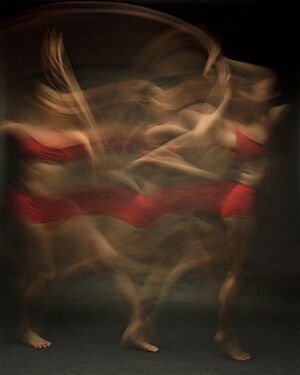 | Motion by Bill Wadman |
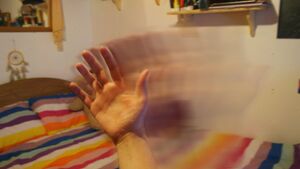 | Tracers by Chelsea Morgan and ohwatever |
 | Shamanic tracers by Anonymous |
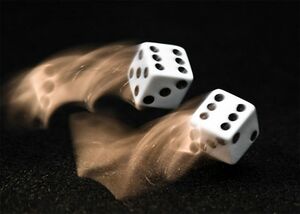 | Tumbling Dice by Rosendahl |
Symmetrical texture repetition
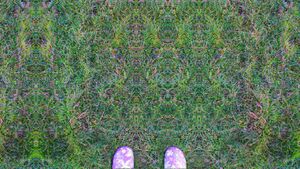
Symmetrical texture repetition is defined as the perception of textures becoming mirrored repeatedly over their own surface in an intricate and symmetrical fashion that is consistent across itself. This maintains the same level of detail no matter how closely one attempts to look at the distortion and tends to remain most prominent within one's peripheral vision. It usually manifests itself in rough textures such as grass, carpets, tree bark, and asphalt.
During this state, if one stares at a fixed point the symmetrical texture repetition may progressively increase and further tesselate into more complex forms. However, this progression of complexity will usually reset back to baseline as soon as one double takes.
Symmetrical texture repetition is often accompanied by other coinciding effects such as pattern recognition enhancement[14][15] and transformations in a manner which can result in the appearance of a huge array of abstract forms and imagery embedded within the symmetry. It is most commonly induced under the influence of mild dosages of psychedelic compounds, such as LSD, psilocybin, and mescaline. However, it can also occur less commonly under the influence of certain stimulants and dissociatives, such as MDMA or 3-MeO-PCP.
Scenery slicing
Scenery slicing is defined as the experience of a person's visual field appearing to split into separate cleanly cut sections, these individual slices then proceed to drift slowly away from their original position before disappearing and resetting to normalcy. This effect typically occurs spontaneously and rarely sustains itself for more than several seconds.
The organisation of these slices can be quite varied; they can be as simple as three separate sections or extremely complex, with formations such as multiple intricate slices of moving interlocking spirals or an infinite variety of other potential geometric designs.
Scenery slicing is often accompanied by other coinciding effects such as environmental cubism and visual disconnection. It is most commonly induced under the influence of moderate dosages of dissociative compounds, such as ketamine, PCP, and DXM. However, it can also occur to a lesser extent under the influence of psychedelics[14] such as LSD, psilocybin, and mescaline.
Image examples
| Caption | |
|---|---|
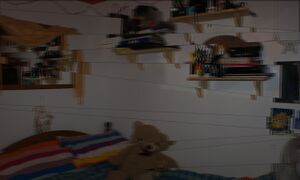 | Dissociative scenery slicing by Chelsea Morgan |
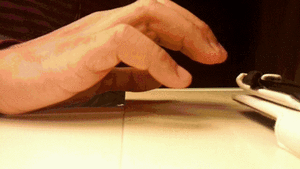 | Scenery Slicing by Subsentience |
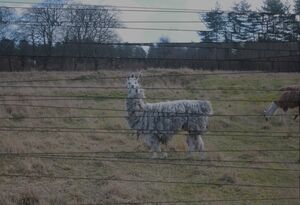 | Llama by Chelsea Morgan |
 | Finn Jumping Rocks by Chelsea Morgan |
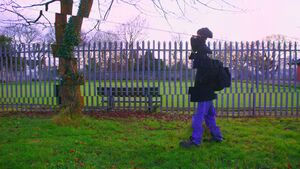 | A Walk in the Park by Chelsea Morgan |
Geometry
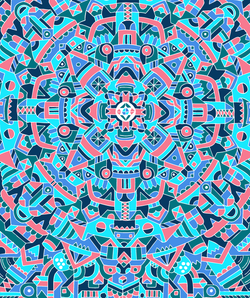
Geometry (also known as visual planforms) is defined as the experience of a person's field of vision becoming partially or completely encompassed by fast-moving, colorful, and indescribably complex geometric patterns,[14][10][16][17][18][19][20] form constants,[21][22] shapes,[17] fractals,[17] and colors. These geometric forms can also become structured and organized in a manner that appears to present genuine information to the person experiencing them far beyond the perception of meaningless, although complex, shapes, and colors. The geometric representations may feel as though they depict specific concepts and neurological processes that exist within the brain in an extremely detailed manner.
Geometry is rarely motionless and is generally extremely fast-moving,[14] and self-changing in regards to its shape and style. During this process, the geometry naturally drifts laterally or radially across the visual field to create overlapping webs of geometric patterns which transition through many distinct states, all of which are visible within a single perceptual frame.
This experience is often accompanied by other coinciding effects such as internal hallucinations,[17] environmental patterning, and drifting. It is most commonly induced under the influence of moderate dosages of psychedelic compounds such as LSD,[17] psilocybin, and mescaline. However, it can also occur to a lesser extent under the influence of cannabinoids, entactogens, and dissociatives such as cannabis,[16] MDMA, and DXM.
Geometry is capable of manifesting itself across known nine different levels of intensity. These tend to depend on the dosage, but can also fluctuate wildly in their intensity due to external triggers such as a person's set and setting. The individual levels are defined below:
1. Visual noise
At the lowest level — which may be experienced in a completely sober state — geometry is perceived as visual noise (also known as visual snow, visual static, or eigengrau), combined with stray light and dark red regions that appear under the eyelids.
2. Motion and color
At this level — which is also obtainable without hallucinogens — the effect can be described as the appearance of unstructured regions of sudden flashes and clouds of color. These are typically referred to as phosphenes and can often be experienced in a sober state by rubbing or applying pressure on or near the closed eyes.
3. Partially defined geometry
At this level, relatively complex shapes and patterns with a vague structure begin to form. These patterns remain strictly two-dimensional. Geometry at this level is fine, small, and zoomed out in size with a dark color palette that typically limits itself to only a few different shades, such as blacks, reds, and dark purples. They are displayed in front of both the open and closed eye visual fields across a flat veil of geometry. However, they are significantly more detailed with the eyes closed or within dark environments.
4. Fully defined geometry
At this level, the detail in which the geometry displays itself becomes profoundly complex and fully structured, but still remains strictly two-dimensional. At this point, the geometry becomes larger in size and extremely intricate in detail with a color palette that is nearly limitless in its possibilities. They are displayed on both the open and closed eye visual field across a flat veil of geometry that floats directly before a person's eyes, remaining significantly more detailed with the eyes closed or in dark environments.
5. 3-Dimensional geometry
At this level, the geometry has become fully three-dimensional in its shape and position across the visual field. This adds a new layer of visual complexity and leaves the geometry sprawled out across the surfaces and objects of a person's environment instead of merely displaying themselves across a basic and flat veil in front of one's visual field.
6. Partially overriding visual perception
At this level, the geometry has become so intense, vivid, and bright that it has begun to block out and replace the external world. The visual perception of a person's environment begins to be replaced by geometry, with objects and scenery either transforming into complex geometric structures or simply being blocked out and covered by them. This occurs in a manner that drastically impairs the use of a person's normal vision. From this level of geometry onwards it is even possible to view geometry which is perceived to be four-dimensional or created from new, ineffable, non-euclidean, or nonsensical geometrical principles, although this is more common at higher levels.
7. Fully overriding visual perception
At this level, the geometry continues to become more intense, vivid, and bright as it begins to completely block out or replace the external world and a person's sense of normal sight become completely impaired. This creates the perception that one is no longer within the external environment, but has "broken through" into another reality of extremely complex and otherworldly geometric forms.
Level 8A and level 8B
At the highest level, geometry is capable of forking off into two separate levels of equal intensity known as level 8A and 8B. Environmental factors, a person's state of mind, and the substance consumed may determine which level a person experiences.
Once visual geometry reaches level 8A or 8B it begins to become structured and organized in a way that appears to present genuine information to the person experiencing it far beyond the preceding seven levels of relatively meaningless, although complex, shapes and colours. This occurs through the perception of innately understood geometric forms that feel as if they depict specific concepts and neurological processes that exist within the brain. Although this is also possible to a much lesser extent at lower levels it does not occur as consistently, and the intensity of it at levels 8A and 8B is significantly higher. At this point concepts can be seen as not just embedded within a person's closed or open eye visual field, but can also be simultaneously felt through indescribably complex physical and cognitive sensations.
It is worth noting that there are particular attributes of psychedelic substances which tend to result in a higher likelihood of level 8A over 8B and vice versa. Psychedelics which are physically stimulating and contain low amounts of hallucinatory content typically result in level 8A. For example, hallucinogens which tend towards causing level 8A include LSD, 2C-B, and 4-HO-MET. In contrast, psychedelics which lead to level 8B are typically sedating in physical effects and contain high amounts of hallucinatory content. For example, hallucinogens which tend towards causing level 8B include psilocybin, LSA, DMT, and 2C-T-7.
8A - Perceived exposure to semantic concept network
8A geometry is one of the two potential final levels of visual geometry; the other is 8B geometry.
A level 8A experience can be described as the feeling of being exposed to a seemingly infinite mass of geometry comprised entirely of innately comprehensible representations which are perceived to simultaneously convey every internally stored concept, memory, process, and neurological structure stored within the mind. This experience is not just perceived through visual geometric data, but is also felt in an incomprehensible level of detail that manifests in the form of complex cognitive and physical sensations. These sensations are felt to convey an equal amount of innately understandable information as that of which is also experienced through a person's vision.
At the lower end of level 8A this effect is something that fluctuates wildly and is neither constant nor consistent in its intensity. Instead, it is momentarily triggered by the experience of a concept. For example, if someone were to say the word "Internet" to a person who is currently undergoing this state they would see the mind's concept of the Internet immediately manifested in a geometric form amidst the very center of their visual field. This form will then quickly branch out from itself in a manner which is similar to a spider diagram or mind map chart, such as a network of geometric nodes descending from an origin concept where each node in the network is directly associated with their parent node, but with each degree of separation from the origin reducing the level of association with the source concept. For example, with the origin concept "Internet" one may have dozens of immediate child nodes that are representative of computers, which may have associated descendant nodes involving technologies, which may have their own children which represent human intelligence, which may also have child nodes involving all concepts related to the evolution of humanity, and so on until all concepts known to the person are represented within the network.
Once this occurs the sensory overload can temporarily disconnect one from their external environment and result in simultaneous long-term memory suppression or "ego death" for several seconds to a minute before a person is returned to reality until something triggers the process again, usually immediately. It is worth noting, however, that at this level it can to a certain extent be disabled through continuous physical movement. This seems to be because movement stops the process from branching out into everything by not giving the effect the time it needs to lock onto a concept.
As the dose of the psychoactive substance is increased, the process becomes easier to trigger while extending its length and duration. This eventually results in a stable state of complete disconnection from the external environment alongside of sustained "ego death" and a lasting sense which is often interpreted as experiencing all of existence in a single instant.
8B - Perceived exposure to inner mechanics of consciousness
8B geometry is one of the two potential final levels of visual geometry; the other is 8A geometry.
The experience of level 8B can be described as the feeling of being exposed to a mass of geometry comprised entirely of innately readable geometric representations which subjectively feel as if they convey the inner mechanics that compose all underlying neurological processes. During this experience, the organization, structure, and programming behind a person's conscious experience are perceived as conceptually understood. It is generally interpreted by those who undergo it as perceiving the supposed inner workings of either the universe, consciousness, or reality. This experience as a whole is perceived through innately understood visual geometric data and is also physically felt in an incomprehensible level of detail through accompanying complex cognitive and tactile sensations.
At the lower end of level 8B geometry, the experience manifests itself as being able to perceive the supposed organization and structure behind one's current conscious thought stream. This is typically presented in the form of a complex, multisensory, and fast-moving network that contains innately understood and relevant geometric representations of specific and abstract concepts. The experience of these innately understandable geometric representations consistently triggers one to visualize and physically feel the concept through highly detailed conceptual thinking.
At the higher end of level 8B geometry, the effect retains its lower levels but expands itself to include the experience of subjectively perceiving, through innately understandable geometric representations, the architecture of subconscious neurological processes which are usually outside of one's normal daily perception or understanding. These processes are often interpreted to include concepts such as the structure of one's neurology, memories, perspectives, emotions, and general cognitive functions.
Level 8B geometry may feel capable of bestowing specific pieces of information onto substance users regarding the nature of reality and human consciousness through the experience of them. These specific pieces of information are usually felt and understood to be a profound unveiling of an undeniable truth at the time, but afterwards they are often found to be either ineffable or simply nonsensical and delusional. Occasionally, however, genuine lessons or coherent messages are innately interpreted through this experience. It’s extremely important to note, that the scientific validity of these lessons is very uncertain and should never be immediately accepted as true without an extremely thorough and sober analysis.
It is worth noting that a greatly simplified and purely cognitive version of this effect is also capable of manifesting itself with no accompanying visual effects.
Image examples
Psychedelic artwork
| Caption | |
|---|---|
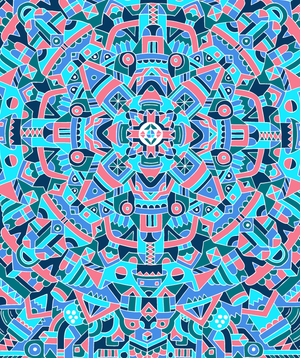 | Switch. by Sam Perkins |
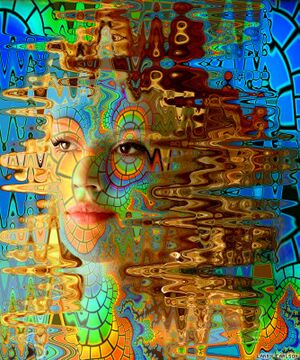 | Breakthrough by Larry Carlson |
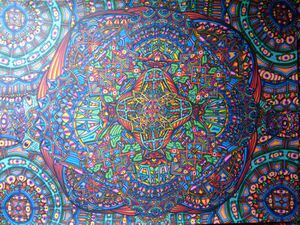 | Untitled by Anonymous |
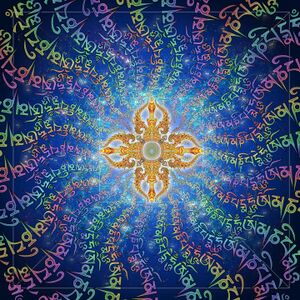 | Untitled by Luke Brown |
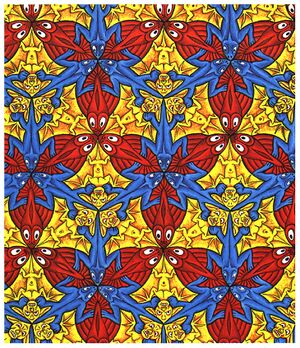 | Tessellation by M. C. Escher |
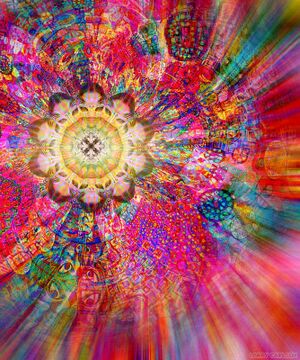 | The Phenakistoscope-diamond by Larry Carlson |
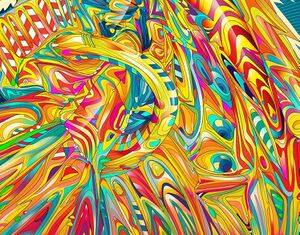 | Untitled by Anonymous |
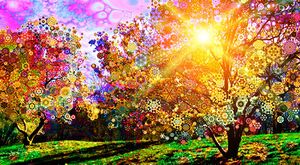 | Magnolia Sun by Larry Carlson |
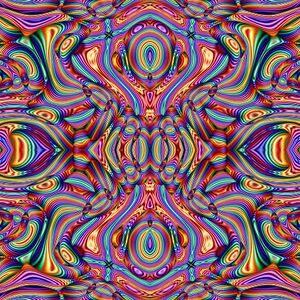 | Untitled by Anonymous |
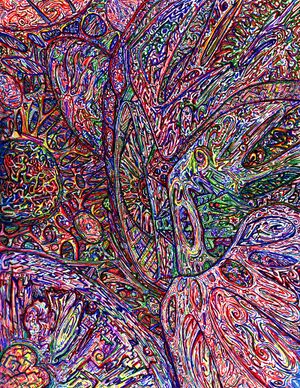 | the eyes have eyes by meerkos |
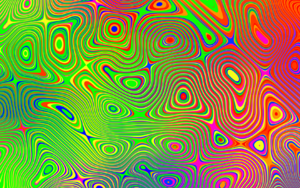 | Untitled by Anonymous |
 | In the tree by Eddie calz |
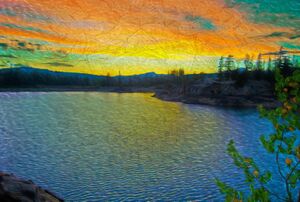 | Lake on LSD by mrmedicman |
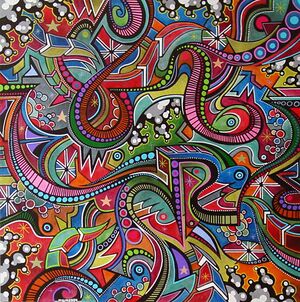 | Abstract by Matt W. Moore |
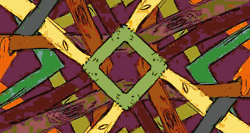 | Wail to god by Anthony F. Schepperd (0:50) |
Fractals
| Caption | |
|---|---|
 | Fractals by Anonymous |
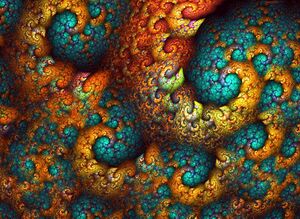 | Fractals by Anonymous |
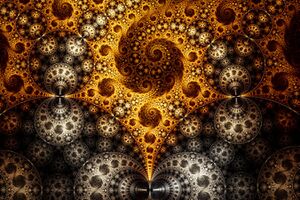 | Fractals by Anonymous |
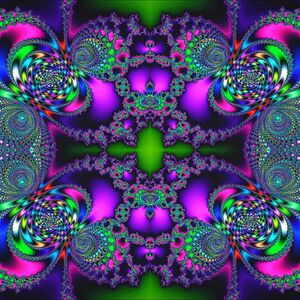 | Zooming into Infinity by Naps284 |
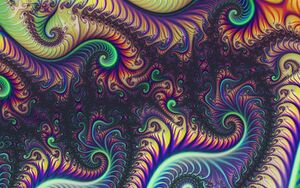 | Fractals by Anonymous |
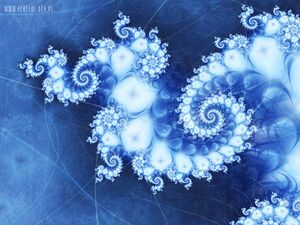 | Fractals by Anonymous |
 | Fractals by Anonymous |
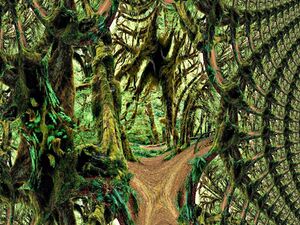 | Fractals by Anonymous |
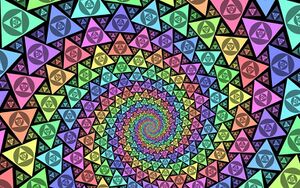 | Fractals by Anonymous |
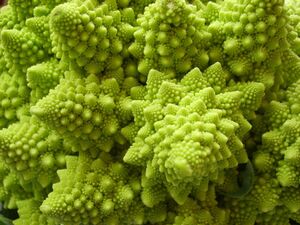 | Natural Fractal - Close-up by Windy Power |
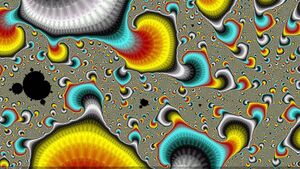 | Fractals by Anonymous |
Shipibo textiles
| Caption | |
|---|---|
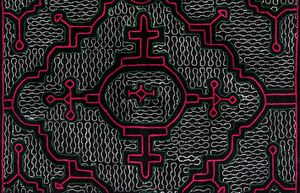 | Untitled by Shipibo-Conibo people |
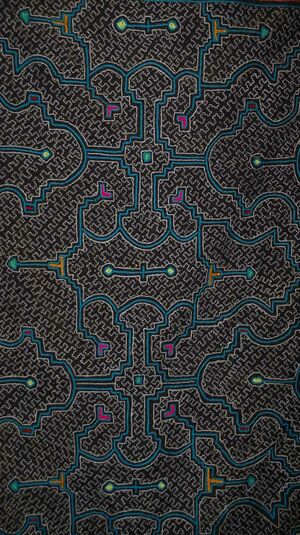 | Untitled by Shipibo-Conibo people |
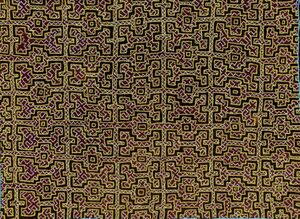 | Untitled by Shipibo-Conibo people |
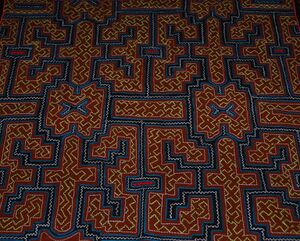 | Untitled by Shipibo-Conibo people |
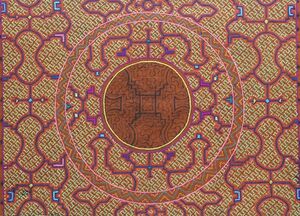 | Untitled by Shipibo-Conibo people |
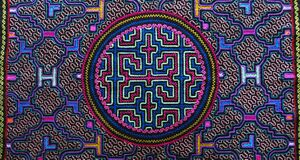 | Untitled by Shipibo-Conibo people |
 | Untitled by Shipibo-Conibo people |
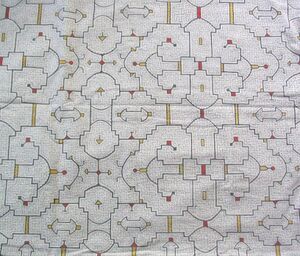 | Untitled by Shipibo-Conibo people |
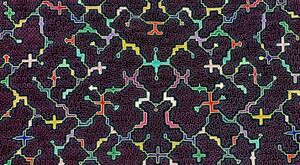 | Untitled by Shipibo-Conibo people |
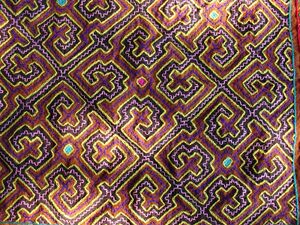 | Untitled by Shipibo-Conibo people |
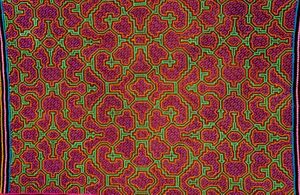 | Untitled by Shipibo-Conibo people |
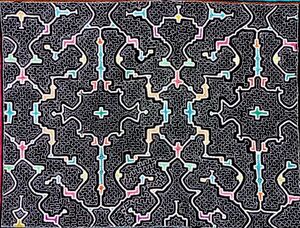 | Untitled by Shipibo-Conibo people |
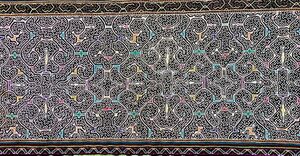 | Untitled by Shipibo-Conibo people |
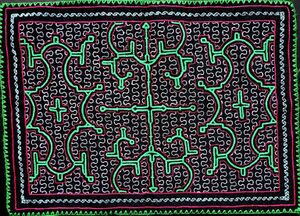 | Untitled by Shipibo-Conibo people |
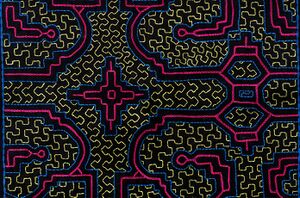 | Untitled by Shipibo-Conibo people |
 | Untitled by Shipibo-Conibo people |
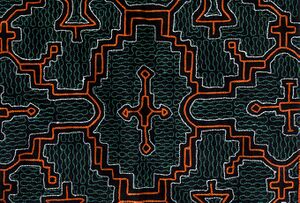 | Untitled by Shipibo-Conibo people |
Variations
The specific differences between each potential style of geometry can be broken down into the following variations:
- Intricate vs. simplistic - Geometry can either present itself as incomprehensibly intricate and complex in its appearance or simplistic, basic and comprehensible even at higher doses. For example, the geometry associated with dissociatives tends to be consistently overly simplistic in form while most psychedelics are significantly more intricate.
- Algorithmic vs. abstract - Geometry can either appear to follow mathematical rules and logically consistent forms in its design (which often results in high amounts of fractals and semi-predictable shapes). In contrast to this, however, geometry can also be completely abstract or random in its appearance in a way that contains an infinite amount of completely unpredictable variety.
- Organic vs. synthetic - Geometry can either feel subjectively organic and natural in its visual style, or it can feel synthetic and digital.
- Unstructured vs. structured - Geometry can either present itself as completely disorganized and unstructured or it can form and condense into a variety of 3-dimensional mechanical and ever-shifting structures which are comprised out of and based upon condensed geometry.
- Dimly lit vs. brightly lit - Geometry can either present itself as extremely dark and hard to make out from its background or, in contrast, it can be brightly lit and extremely easy to distinguish from its background. For example, the geometry associated with dissociatives tends to be consistently darker in appearance while most psychedelics are significantly brighter.
- Multicolored vs. monotone - The color scheme that geometry follows can range from extremely varied and multicolored in style to consisting of little (if any) color variety such as grays, purples and blacks
- Flat shading vs. glossy shading - The shading of geometry can either be flat, bright and simplistic or glossy with depth, gradients, highlights, and shading.
- Sharp edges vs. soft edges - Geometry can have sharp edges which are extremely well-defined around its perimeter (sometimes with thick black outlines around its edges). In contrast to this, they can also be soft and blurred around the edges, merging seamlessly into each other in a manner which does not affect its intricacy.
- Large vs. small - Regarding its size, geometry can be extremely large and zoomed in or fine and zoomed out in a way that does not affect its level of intricacy.
- Fast vs. slow - In terms of its speed, geometry can shift and morph so fast into itself that the amount of information presented to the tripper in extremely short periods of time becomes incomprehensible to process. In contrast to this, they can move slowly and comprehensibly, swirling and shifting into themselves to present ever-changing geometric forms that can be observed at a much higher level of detail.
- Smooth vs. jittery - In terms of its motion, geometry can move smoothly with a high frame rate, or it can be jittery in its motion with lag and a low frame rate.
- Round corners vs. angular corners - Geometry can either have mostly rounded and circular corners or mostly sharp corners with sharp and angular geometry.
- Non-immersive vs. immersive - Geometry can be manifested in front of one's face in a manner which feels separate and as if it was being presented on some screen without a distinct sense of size or distance attributed to it. In contrast, geometry can feel as if one is completely immersed in and surrounded by it with a distinct sense of attributed size and distance.
- Consistent vs. progressive - Geometry can be manifested as consistent and steady in its intensity, complexity and visibility regardless of disturbances within the external environment. In contrast, however, it can manifest as progressive in its intensity which means that disturbances and sensory input such as bright lights, loud noises and distractions within the external environment will prevent or cut off the intensity, complexity and visibility from building up to its limit whilst darkness will cause it to steadily rise in complexity.
- Level 8A vs. level 8B - At its eighth and highest level of experience, geometry is capable of branching off into two different directions of equal intensity. The first of these is Level 8A – exposure to semantic concept network and the second of these is Level 8B – exposure to the internal mechanics of consciousness.
Hallucinatory states
Transformations
Transformations are defined as the experience of a perceived visual metamorphosis that specific parts of one's external environment undergo as they shapeshift into other objects. For example, people who undergo this effect will often report seeing parts of their environment shifting into completely different things. These transformations have a huge variety of potential artistic styles and differing levels of detail, realism, and animation.
These hallucinations are progressive in nature, which means they form by arising from patterns or objects and then, over a period of seconds, the object smoothly drifts in a fluid-like motion into an entirely new form. This is significantly enhanced and fueled by the separate visual effect of pattern recognition enhancement. It causes vague stimuli and objects to transform into incredibly detailed versions of what they were already perceived as being.
At lower levels, the process of transformation can require some minimal amount of focus and concentration to sustain and will appear more often in the peripheral field of vision. Losing concentration for an instant can cause the image to fade away or shift into another image. Holding the eyes still will usually increase the intensity of the progressive transformation. However, at higher levels, this becomes completely unnecessary.
It is worth noting that the content, style, and general behaviour of a transformation is often largely dependent on the emotional state of the person experiencing it. For example, a person who is emotionally stable and generally happy will usually be more prone to experiencing neutral and interesting transformations. In contrast, however, a person who is emotionally unstable and generally unhappy will usually be more prone to experiencing sinister and fear-inducing transformations which have the potential to exacerbate even more the negative feelings.
Transformations are often accompanied by other coinciding effects such as drifting, pattern recognition enhancement and external hallucinations. They are most commonly induced under the influence of moderate dosages of psychedelic compounds, such as LSD, psilocybin, and mescaline. However, they can also occur under the influence of deliriants such as DPH, datura, and benzydamine.
External hallucinations
An external hallucination is defined as the perception of a visual hallucination which displays itself seamlessly into the external environment as if it were actually happening.[25][26] This is in stark contrast to internal hallucinations, such as dreams, that occur exclusively within an imagined environment and can typically only be viewed with closed eyes.
This effect is capable of manifesting itself across the 4 different levels of intensity described below:
- Fleeting hallucinations - At the lowest level, external hallucinations generally consist of movement within the peripheral vision and ill-defined, fleeting hallucinations which disappear once a person double takes.
- Vaguely defined hallucinations - At this level, the hallucinations are visible within one's direct line of sight, but are not fully defined in their appearance. This means that, although visible, they do not look completely detailed and are often extremely blurry or semi-translucent with little, if any, colour.[26]
- Partially defined hallucinations - At this level, the hallucinations become distinct enough in their detail and vividness to extend beyond transparent, colourless, or blurry manifestations. However, they still remain unconvincing and do not quite live up to the detail of everyday life.
- Fully defined hallucinations - At this level, the hallucinations have become completely realistic and will rarely disappear simply because a person double takes. They are now capable of a completely convincing and photorealistic appearance and their behaviour becomes far more lifelike. Additionally, they may become numerous enough to fully engulf the entirety of the person's environment.[26]
Alongside a specific levelling system, there are also certain environmental factors that directly alter both the likelihood of external hallucinations manifesting themselves and the level of detail of which they are rendered with. For example, the more unfamiliar with the external environment a person is, the more likely it is that this effect will manifest itself. Cluttered areas tend to produce more external hallucinations and the amount of light within a room is inversely proportional to the intensity of them, with less light leading to significantly more hallucinations and more light leading to fewer, although more detailed, hallucinations.
The content within these external hallucinations can be further broken down into four distinct subcomponents. These are described and documented within their own dedicated articles, each of which are listed below:
- Autonomous entities
- Object activation
- Perspective hallucination
- Scenarios and plots
- Settings, sceneries, and landscapes
- Shadow people
It is worth noting that the content, style, and general behaviour of an external hallucination is often largely dependent on the emotional state of the person experiencing it. For example, a person who is emotionally stable and generally happy will usually be more prone to experiencing neutral, interesting, or positive hallucinations. In contrast, however, a person who is emotionally unstable and generally unhappy will usually be more prone to experiencing sinister, fear-inducing, and negative hallucinations.
External hallucinations are often accompanied by other coinciding effects such as delirium, internal hallucinations and delusions. They are most commonly induced under the influence of heavy dosages of deliriant compounds, such as DPH, datura, and benzydamine. However, they can also occur less commonly under the influence of psychedelics, dissociatives, stimulant psychosis, and sleep deprivation.
Internal hallucinations
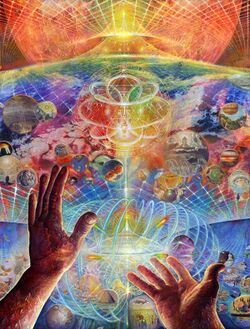
An internal hallucination is defined as the perception of a visual hallucination that exclusively occurs within an imagined environment which can typically only be viewed with closed eyes,[27][28] similar to those found within dreams.[29][30][31] This is in stark contrast to external hallucinations, which display themselves seamlessly into the external environment as if they were actually happening.
At lower levels, internal hallucinations begin with imagery on the back of a person's eyelids which do not take up the entirety of one's visual field and are distinct from their background. These can be described as spontaneous moving or still images of scenes, concepts, places, and anything one could imagine. The imagery is manifested in varying levels of realism, ranging from ill-defined and cartoon-like in nature to wholly realistic. They rarely hold their form for more than a few seconds before fading or shifting into another image. It is worth noting that this level of intensity occurs in a highly similar manner to that of hypnagogia, the state between sleep and wakefulness.
At higher levels, internal hallucinations become increasingly elaborate as they eventually become all-encompassing, fully-fledged 3D scenes which surround the person in a similar manner to that of dreams. This can create the feeling that one has "broken-through" into another reality. The things which occur within this perceived alternate reality can be anything but fall under common archetypes, such as contact with autonomous entities alongside a wide variety of imagined landscapes, and scenarios.
This effect is capable of manifesting itself across the 5 different levels of intensity described below:
- Enhancement of mental visualization - At the lowest level internal hallucinations can be defined as a distinct enhancement of mental visualisation that a person drifts into when daydreaming or using their imagination. It can be described as a short-term detachment from one's immediate surroundings, during which a person's contact with reality is blurred and partially substituted by an ill-defined fantasy. The details of this internal visualisation are slightly spontaneous or autonomous in nature but are mostly controlled by the content of one's current thought stream.
- Partially defined imagery - At this level, internal hallucinations consist of partially defined, blurred, and faded imagery within a person's visual field.
- Fully defined imagery - At this level, the vividness and intensity increases in a fashion which renders the imagery seen within one's visual field as fully defined and realistic in its appearance.
- Partially defined immersion - At this level, the vividness, scope, and intensity of the hallucinations become all-encompassing in a way which begins to display momentary flashes of scenes which surround the person in an immersive environment in a similar fashion to that of a vague dream. Although all-encompassing, they are often blurred or transparent in appearance, and a person's physical body still feels as if it is partially connected to the real world.
- Fully defined immersion - At the highest level, the internal hallucinations further increase to become all-encompassing in a manner which displays long-lasting scenes which surround the person with an explorable and fully immersive environment which is similar to that of a dream. This occurs in a fashion which is entirely realistic, detailed, and highly vivid in its appearance. It typically also occurs alongside relevant auditory and tactile hallucinations, as well as the sensation that a person has become completely disconnected from their physical body.
The content within these external hallucinations can be further broken down into four distinct subcomponents. These are described and documented within their own dedicated articles, each of which are listed below:
- Autonomous entities
- Object activation
- Perspective hallucination
- Scenarios and plots
- Settings, sceneries, and landscapes
- Shadow people
It is worth noting that the content, style, and general behaviour of an internal hallucination is often largely dependent on the emotional state of the person experiencing it. For example, a person who is emotionally stable and generally happy will usually be more prone to experiencing neutral, interesting, or positive hallucinations. In contrast, however, a person who is emotionally unstable and generally unhappy will usually be more prone to experiencing sinister, fear-inducing, and negative hallucinations.
Internal hallucinations are often accompanied by other coinciding effects such as geometry, external hallucinations and delusions. They are most commonly induced under the influence of heavy dosages of hallucinogenic compounds, such as psychedelics, dissociatives, and deliriants. However, they can also occur under the influence of stimulant psychosis, sleep deprivation, and during dreams.
Transition styles
Internal hallucinations typically last anywhere between 30 seconds and several minutes before the person slips back into reality or the presence of another hallucination. There are several different methods through which these hallucinations are transitioned between, these are described and documented below:
- Zooming - Images can switch between each other via the experience of one's vision zooming into or out of the current image to such an extent that it reveals an entirely new hallucination.
- Morphing - Images can switch between each other by transforming the details of their shape and structure to show an entirely new image. This can happen in a variety of different speeds and typically occurs in the style of a fluidlike motion.
- Sliding - Images can switch between each other by sliding in a specific direction which then reveals an entirely new image behind them.
- Fading - Images can change between each other by fading into nothingness before a completely new image fades back into view.
- Splitting - Images can switch between each other by splitting into two or more sections which drift away from each other to reveal an entirely new hallucination behind it.
- Tiling - Images can switch between each other by separating into geometric formations which then slide or fade away from each other to reveal an entirely new hallucination behind them.
Autonomous entities
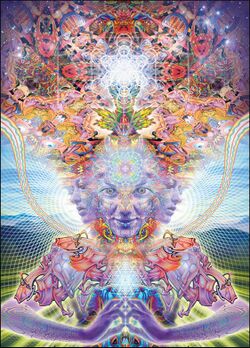
An autonomous entity is defined as the experience of perceived contact with beings which appear to be sentient and autonomous in their behaviour.[32][33][34][35][36][37][38][39] These entities can manifest within both external and internal hallucinations.[38]
Autonomous entities will frequently act as the inhabitants of a perceived independent reality.[37] Although many entities seem largely unaware of a person’s presence they are often precognizant of a person's appearance into their realm and usually choose to interact with them in various ways.
The behaviour of a typical entity can vary wildly and seems to depend heavily on one's current emotional state. For example, while many entities will act as loving beings, teachers, or healers in certain contexts they are equally capable of acting as indifferent, uncaring or even as malicious tormentors.[34][39]
Entities can take any form but subconscious archetypes are present and commonly include:[34][39]
Humans, shadow people, bodiless super intelligent humanoids, aliens, elves, animals, giant spheres, insectoids, beings of light, anthropomorphic beings, plants, conscious inanimate objects, fictional characters, cartoons, robotic machines, gods, demigods, goddesses, bio-mechanical intelligences, hooded figures, demons, indescribable monstrosities, spirits, angels, shamans, ghosts, souls, ancestors, fantastical or mythological beasts, glitch creatures and more.
This experience is often accompanied by other coinciding effects such as geometry,[35] internal hallucinations and delusions. It is most commonly induced under the influence of heavy dosages of hallucinogenic compounds, such as psychedelics, dissociatives, and deliriants. However, it can also occur under the influence of stimulant psychosis, sleep deprivation, and during dreams.
Debate over the existence of autonomous entities
The question of whether these autonomous entities are real or not has often been subject of discussion.
Assuming that our consciousness is formed by a complex and specific arrangement of neural networks, they can be said to be a consequence of the emergent properties of our brain. These perceived entities could be generated by transient changes in brain connectivity induced by certain substances.
For example, an increase in functional connectivity between or inside certain areas of the brain could cause a higher likelihood of the formation of various separated complex structures, which in some cases could be complex enough to be perceived as self-conscious or even have (or give the illusion to have) a higher intelligence than the perceiver.
This would mean that these entities, even though most of the times perceived as separated from our Self, are complex structures emerged by changes in our neural pathways. In a certain way they would be as real as we define ourselves to be (as a "conscious" being), because both our consciousness and the entities are formed by specific complex structures inside the brain. The same argument could be used in many other cases with other kinds of hallucinations and could even lead to the questioning of the definition of reality itself.
Another common hypothesis is that these entities already exist inside our subconscious and/or unconscious and are perceived by the conscious part of the brain due to an abnormal change in connectivity. The presence of certain entities within the unconscious has been widely discussed even in classic psychological literature. For example some of the archetypes hypothesized by Carl Gustav Jung were described as self-conscious entities.
These two hypothesis do not appear to be in conflict with each other, since the presence of innate entities within the psyche and the momentary or permanent formation of others do not exclude each other.
Personality types
There are several distinct personality types of autonomous entity which one may potentially encounter. They are often perceived to represent a particular subsection of a person’s own consciousness and can be identified primarily through their personality, but also their appearance. These individual types are broken down into three separate categories below:
- Representations of general concepts - This personality type can be described as a seemingly sentient representation of any known concept. This will usually adopt an appropriate personality and set of mannerisms to fit the chosen concept with an impressive degree of detail. For example, the specific concept could include other people that the person has met throughout their life, specific fictional characters or symbolic representations of concepts such as abstract ideas, emotions, or key parts of one's own personality.
- Representations of the self - This personality type can be described as a copy of one's own personality. It can take any visible form but when conversed with it clearly adopts an identical vocabulary and set of mannerisms to one's own consciousness.
- Representations of the subconscious - This personality type can be described as an entity which may take any visible form, but is also subjectively perceived to be an autonomous controller behind the continuous generation of the details of the person’s current hallucinations. They may also be felt to simultaneously control or manage one's current perspective, personality, and internally stored model of reality. When interacted with, this category of entity can often possess abilities which allow them to directly alter and manipulate one's current experiences. They commonly want to teach or guide the person and will operate under the assumption that they know what is best for them. However, it cannot be known whether this hallucination is genuinely a representation of the subconscious or is merely an approximation which behaves in a convincing manner.
Communication styles
Autonomous entities can communicate with a person via a combination of spoken word, “telepathy”, conceptual thoughts, mathematics, and geometry-based visual linguistics which generally consists of morphing colored structures of different textures that are innately understandable as representations of specific concepts. They will often convey insights regarding overcoming personal issues within a person’s life and will occasionally help clarify philosophical or spiritual ideas. However, more often than not entities are very likely to speak in a cryptic or nonsensical manner which seems to have no clear meaning behind it.
It is important to note that autonomous entities can never convey novel information to the person experiencing them. For example, they cannot provide insights about the external world which a person did not already know on some level. Instead, they can only provide alternative perspectives and help build upon existing ideas. This is presumably because autonomous entities do not have access to any knowledge which is not already contained within one's conscious or subconscious memories. May contain imprints of genetic memories, access to lifetimes that seem parallel or events that mirror one's connectivity moving past the default mode.
When communicated with through spoken word, the level of coherency in which these entities can communicate with is highly variable but can be broken down into four distinct levels. These are described and listed below:
- Silence - At the lowest level, the effect can be described as a complete unresponsiveness from the entity and a lack of speech despite their presence within the hallucination.
- Partially defined incoherent speech - At this level, the effect can be described as linguistic conversational responses and noises which almost sound like words but do not contain any real content or meaning beyond a vague sense of emotional intent.
- Fully defined incoherent speech - At this level, the effect can be described as audible linguistic conversational responses and noises which contain fully defined and understandable words, but often lack grammatical structure or an overall sense of general coherency.
- Partially defined coherent speech - At this level, the effect can be described as linguistic conversational responses which contain fully defined and understandable words with a partially defined grammatical structure and general coherency. It conveys its point on a level which is frequently coherent, but may not always be fully understandable and will sometimes descend into broken English or even gibberish.
- Fully defined coherent speech - At the highest level, the effect can be described as linguistic conversational responses which contain understandable words and fully defined grammatical sentence structures. It has an overall sense of general coherency which conveys its point in a level of detail that is genuinely on par with that of a person’s own intellect.
Image examples
| Caption | |
|---|---|
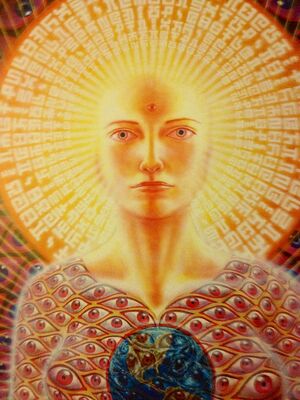 | Sophia by Alex Grey |
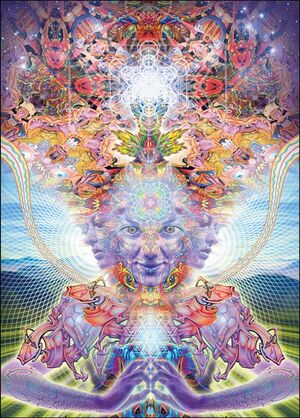 | Namaste (Trifoliata Mystica) by Luke Brown |
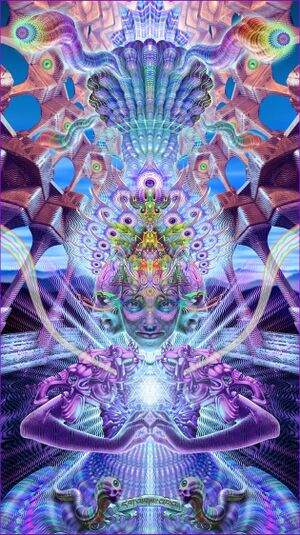 | Apotheosis by Luke Brown |
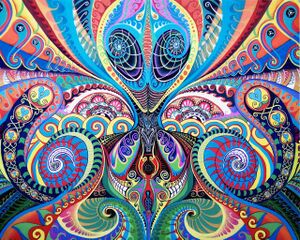 | Untitled by Anonymous |
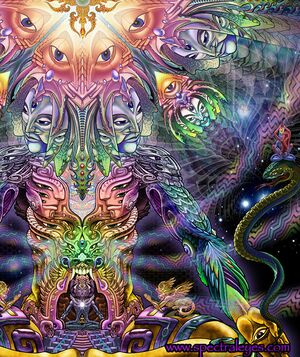 | Alpha Centauri by Luke Brown |
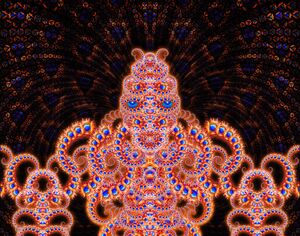 | Id-Aliunde by Beau Deeley |
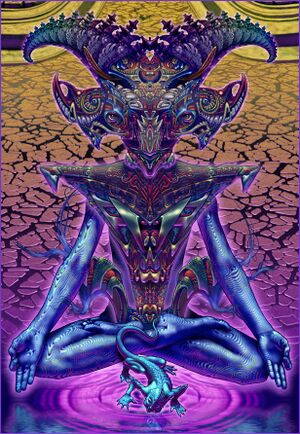 | Jerrestrial detail by Luke Brown |
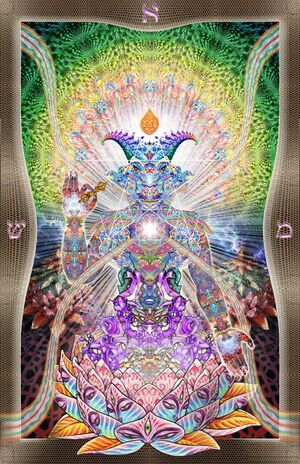 | Baphomet by Luke Brown |
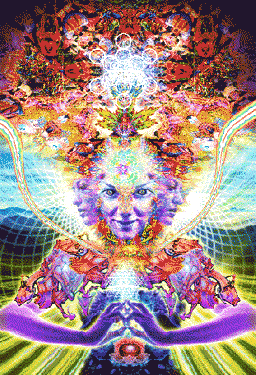 | Namaste 3D by Luke Brown |
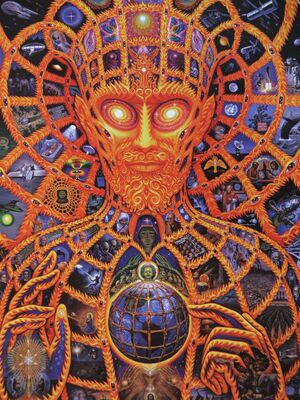 | Cosmic Christ by Alex Grey |
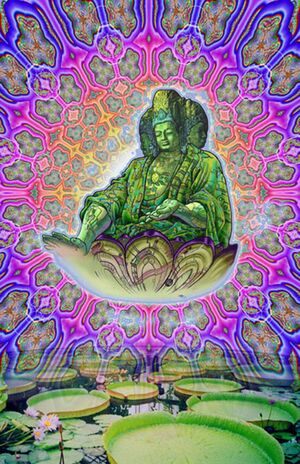 | Maitreya by Luke Brown |
Scenarios and plots
Scenarios and plots are the situations, stories, scenarios, and events which occur within both external and internal hallucinations. These behave in an almost identical fashion to the plots and scenarios that occur during ordinary dream states and often include cognitive delusions that result in one accepting the plot as a real life event. On rare occasions, however, they will be immediately recognized as a mere hallucination and not a real life event.
During this effect, the typical components which comprise standard hallucinatory states (settings, sceneries, and landscapes and autonomous entities) begin behaving and co-operating in a manner which results in the experience of events occurring within the hallucination itself. These are often perceived as linear and coherent plots that occur in a logical sequence by leading into other events through normal cause and effect. However, they are equally likely to present themselves as completely nonsensical and incoherent. For example, they may consist of nonlinear or spontaneous events which are capable of ending, starting, and changing between each other repeatedly in quick succession.
These hallucinated plots can consist of new experiences that are completely unlike the real world, old experiences such as accurate memory replays, or a combination of the two. However, in terms of their precise content, this effect is impossible to define in a comprehensive manner in much the same way that one cannot predict the exact plot of unknown literature and films. They can, however, be summarized as basic occurrences which often entail visiting a setting that contains interactive objects and autonomous entities. It is also worth noting that the possible situations one may find themselves in as a result of this effect can be either positive or negative to experience in a manner which is dependent on both its content and the individual undergoing them.
Hallucinatory plots and scenarios usually feel as if they are being experienced in real-time. For example, when 20 seconds has passed within the hallucination, the same amount of time will usually have passed in the real world. At other points, however, time distortion can occur, resulting in plots and scenarios that can feel as if they last days, weeks, months, years, aeons, or infinitely extended periods.
Scenarios and plots are most commonly induced under the influence of heavy dosages of hallucinogenic compounds, such as psychedelics, dissociatives, and deliriants. However, they can also occur less commonly under the influence of stimulant psychosis, and sleep deprivation.
Perspective alterations
A perspective hallucination is defined as an alteration of the perspective through which a given internal or external hallucination is seen through.[40][25][41][42][43]
This effect is capable of manifesting itself across the four different perspectives described below:
- 1st person - The most common form of perspective can be described as the normal experience of perceiving a hallucination from the person's everyday self and body.
- 2nd person - This perspective can be described as the experience of perceiving a hallucination from the viewpoint of an external source of consciousness, such as another person, an animal, or an inanimate object.
- 3rd person - This perspective can be described as an out-of-body experience[40][25][41][42][43][44][45] where a person's viewpoint is floating above, below, behind, or in front of their physical body.
- 4th person - The least common form of perspective can be described as the experience of perceiving a hallucination from multiple or even seemingly infinite viewpoints and angles simultaneously.
Perspective hallucinations are often accompanied by other coinciding effects such as delirium, and memory suppression. They are most commonly induced under the influence of heavy dosages of hallucinogenic compounds, such as psychedelics, dissociatives, and deliriants.
Settings, sceneries, and landscapes
Settings, sceneries, and landscapes are defined as the perceived environment in which the plot of an internal or external hallucination occurs.[46] This effect is capable of manifesting in a seemingly infinite variety of potential places and settings.
When explored, the geography of these settings is capable of organizing itself as static and coherent. However, they may also manifest as a non-linear, nonsensical, and continuously changing layout which does not obey the laws of physics. The chosen locations, appearance, and style of these settings may be entirely new and previously unseen locations; however, there is a large influence towards replicating and combining real-life locations stored within a person's memories. There are some common themes and archetypes within this component which generally include:
Jungles, rainforests, deserts, ice-scapes, cities, natural environments, caves, space habitats, vast structures, civilizations, technological utopias, ancient ruins, machinescapes, historical settings, rooms and other indoor environments, real-life locations, incomprehensible geometric landscapes and more.
It is worth noting that the content, style, and general behaviour of a setting is often largely dependent on the emotional state of the person experiencing it. For example, a person who is emotionally stable and generally happy will usually be more prone to experiencing neutral, interesting, or positive settings. In contrast, however, a person who is emotionally unstable and generally unhappy will usually be more prone to experiencing sinister, fear-inducing, and negative settings.
Settings, sceneries, and landscapes are often accompanied by other coinciding effects such as autonomous entities and delusions. They are most commonly induced under the influence of heavy dosages of hallucinogenic compounds, such as psychedelics, dissociatives, and deliriants. However, they can also occur under the influence of stimulant psychosis and during dreams.
Shadow people
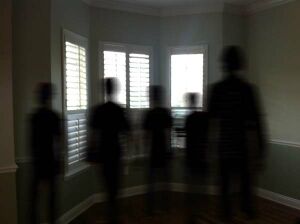
Shadow people are defined as the experience of perceiving patches of shadow in one's peripheral or direct line of sight that appear and behave as living, autonomous beings.[25][47][48] Due to the unique behavior of these hallucinations they can be considered as a distinct sub-type of autonomous entity.
Shadow people usually, but not always, begin to appear initially as fleeting images in a person's peripheral vision. However, at higher levels of intensity shadow people may begin to appear in full view in a manner which allows them to be directly looked at. At advanced mental states, it is even possible to look away from and look back at the shadow person without a change in the presence or appearance of the hallucination.
The bodies of these shadow people are usually perceived as being comprised of a type of blackness that has a sense of depth with few facial or bodily features. The blackness of their bodies often seem almost opaque, as if one is looking into a "black hole" in humanoid form. They may also appear in the shape of animals, uniform blobs, disembodied body parts, or a myriad of other indescribable shapes. They sometimes appear to have faces, eyes, or mouths and are able to move or change shape. The movement exhibited can be normal human movement or it can be faster, slower, or more choppy than a normal person's gait. It is also possible for multiple shadow people to occupy one's field of vision simultaneously while acting autonomously from one another and even interacting with each other.
It is worth noting that the style and general behaviour of a shadow person are often largely dependent on the emotional state of the person experiencing it. For example, a person who is emotionally stable and generally happy will usually be more prone to experiencing neutral, interesting, or friendly shadow people. In contrast, however, a person who is emotionally unstable and generally unhappy will usually be more prone to experiencing sinister and fear-inducing shadow people.
Shadow people are often accompanied by other coinciding effects such as delirium, paranoia, anxiety, and feelings of impending doom. They are most commonly induced under the influence of heavy dosages of deliriant compounds, such as DPH, datura, and benzydamine. However, they can also occur under the influence of stimulant psychosis, sleep deprivation, and during sleep paralysis.[49]
Multisensory aspects
Although it is uncommon and not an intrinsic part of this hallucinatory effect shadow people can sometimes be accompanied by other sensory components alongside of the person's visual perception of them. This is typically infrequent and usually only occurs during very intense states of sleep deprivation, delirium, or psychosis. For example, shadow people can potentially have an accompanying "voice", despite the lack of a visible mouth structure. This auditory communication follows an identical leveling system of progressively more detailed and coherent spoken word in the same manner as a generic autonomous entity. Shadow people may converse with the person experiencing them or they may converse amongst each other, sometimes talking about the person going through the experience.
Alongside of accompanying auditory hallucinations, shadow people may also present tactile and gustatory hallucinations. This is even rarer than their potential auditory effects and typically only occurs in particularly intense and advanced hallucinatory states. Their tactile effects can be indistinguishable from a real human touch and may vary in temperature. They can also even include physical actions such as pulling of clothing, hair, or the skin.
See also
References
- ↑ Fischer, Roland; Hill, Richard; Thatcher, Karen; Scheib, James (1970). "Psilocybin-induced contraction of nearby visual space". Agents and Actions. 1 (4): 190–197. doi:10.1007/BF01965761. ISSN 0065-4299.
- ↑ Kleinman, J. E.; Gillin, J. C.; Wyatt, R. J. (1977). "A Comparison of the Phenomenology of Hallucinogens and Schizophrenia From Some Autobiographical Accounts*". Schizophrenia Bulletin. 3 (4): 560–586. doi:10.1093/schbul/3.4.560. ISSN 0586-7614.
- ↑ 3.0 3.1 Marsh, A. (1979). "Visual Hallucinations During Hallucinogenic Experience and Schizophrenia". Schizophrenia Bulletin. 5 (4): 627–630. doi:10.1093/schbul/5.4.627. ISSN 0586-7614.
- ↑ Szara, S. The comparison of the psychotic effect of tryptamine derivatives with the effects of mescaline and LSD-25 in self-experiments. In: Garattini, S., and Ghetti, V., eds. Psychotropic Drugs. Amsterdam: Elsevier Publishing Company, 1957. pp. 460-467. https://www.erowid.org/references/texts/show/1667docid1552
- ↑ Hofmann, A. Psychotomimetic drugs, chemical and pharmacological aspects. Acta Physiologica Pharmacologica Neerlandica, 8:240-258, 1959. http://www.samorini.it/doc1/alt_aut/ek/hofmann-psychotomimetic-drugs.pdf
- ↑ Sechehaye, Marguerite; Rubin-Rabson, Grace (1951). "Autobiography of a schizophrenic girl: Reality lost and gained, with analytic interpretation". doi:10.1037/11511-000.
- ↑ Dubois, Julien; VanRullen, Rufin (2011). "Visual Trails: Do the Doors of Perception Open Periodically?". PLoS Biology. 9 (5): e1001056. doi:10.1371/journal.pbio.1001056. ISSN 1545-7885.
- ↑ Abraham, H. D., Mccann, U. D., Ricaurte, G. A. (2002), "Psychedelic Drugs", CiteSeerX
- ↑ O'Malley, John E. (1972). "Trifluoperazine for The "Trailing" Phenomenon". JAMA: The Journal of the American Medical Association. 220 (9): 1244. doi:10.1001/jama.1972.03200090066017. ISSN 0098-7484.
- ↑ 10.0 10.1 Abraham, Henry David (1983). "Visual Phenomenology of the LSD Flashback". Archives of General Psychiatry. 40 (8): 884. doi:10.1001/archpsyc.1983.01790070074009. ISSN 0003-990X.
- ↑ Abraham, Henry D.; Wolf, Ernst (1988). "Visual function in past users of LSD: Psychophysical findings". Journal of Abnormal Psychology. 97 (4): 443–447. doi:10.1037/0021-843X.97.4.443. ISSN 1939-1846.
- ↑ Asher, Harvey (1971). ""Trailing" Phenomenon—A Long-Lasting LSD Side Effect". American Journal of Psychiatry. 127 (9): 1233–1234. doi:10.1176/ajp.127.9.1233. ISSN 0002-953X.
- ↑ Schwartz, K. (1997). "Nefazodone and visual side effects". American Journal of Psychiatry. 154 (7): 1038a–11038. doi:10.1176/ajp.154.7.1038a.
- ↑ 14.0 14.1 14.2 14.3 Papoutsis, Ioannis; Nikolaou, Panagiota; Stefanidou, Maria; Spiliopoulou, Chara; Athanaselis, Sotiris (2014). "25B-NBOMe and its precursor 2C-B: modern trends and hidden dangers". Forensic Toxicology. 33 (1): 1–11. doi:10.1007/s11419-014-0242-9. ISSN 1860-8965.
- ↑ Bersani, Francesco Saverio; Corazza, Ornella; Albano, Gabriella; Valeriani, Giuseppe; Santacroce, Rita; Bolzan Mariotti Posocco, Flaminia; Cinosi, Eduardo; Simonato, Pierluigi; Martinotti, Giovanni; Bersani, Giuseppe; Schifano, Fabrizio (2014). "25C-NBOMe: Preliminary Data on Pharmacology, Psychoactive Effects, and Toxicity of a New Potent and Dangerous Hallucinogenic Drug". BioMed Research International. 2014: 1–6. doi:10.1155/2014/734749. ISSN 2314-6133.
- ↑ 16.0 16.1 Bressloff, Paul C.; Cowan, Jack D.; Golubitsky, Martin; Thomas, Peter J.; Wiener, Matthew C. (2002). "What Geometric Visual Hallucinations Tell Us about the Visual Cortex". Neural Computation. 14 (3): 473–491. doi:10.1162/089976602317250861. ISSN 0899-7667.
- ↑ 17.0 17.1 17.2 17.3 17.4 Juszczak, Grzegorz R.; Swiergiel, Artur H. (2013). "Recreational Use of D-Lysergamide from the Seeds ofArgyreia Nervosa,Ipomoea Tricolor, Ipomoea Violacea,andIpomoea Purpureain Poland". Journal of Psychoactive Drugs. 45 (1): 79–93. doi:10.1080/02791072.2013.763570. ISSN 0279-1072.
- ↑ Muthukumaraswamy, S. D.; Carhart-Harris, R. L.; Moran, R. J.; Brookes, M. J.; Williams, T. M.; Errtizoe, D.; Sessa, B.; Papadopoulos, A.; Bolstridge, M.; Singh, K. D.; Feilding, A.; Friston, K. J.; Nutt, D. J. (2013). "Broadband Cortical Desynchronization Underlies the Human Psychedelic State". Journal of Neuroscience. 33 (38): 15171–15183. doi:10.1523/JNEUROSCI.2063-13.2013. ISSN 0270-6474.
- ↑ Siegel RK, Jarvik ME: Drug-induced hallucinations in animals and man, in Siegel RK, West LJ (eds): Hallucinations. New York, John Wiley & Sons Inc, 1975, pp 81-162
- ↑ Klüver, H. (1928). Mescal, and mechanisms of hallucinations. University of Chicago Press.
- ↑ Tyler, Christopher W. (1978). "Some new entoptic phenomena". Vision Research. 18 (12): 1633–1639. doi:10.1016/0042-6989(78)90255-9. ISSN 0042-6989.
- ↑ Young, Rockefeller S.L.; Cole, Robert E.; Gamble, Michael; Rayner, Martin D. (1975). "Subjective patterns elicited by light flicker". Vision Research. 15 (11): 1291–1293. doi:10.1016/0042-6989(75)90177-7. ISSN 0042-6989.
- ↑ http://www.united-academics.org/magazine/mind-brain/first-interactive-categorized-map-of-the-brain/
- ↑ http://gallantlab.org/semanticmovies/
- ↑ 25.0 25.1 25.2 25.3 Obreshkova, D., Kandilarov, I., Angelova, V. T., Iliev, Y., Atanasov, P., & Fotev, P. S. (2017). PHARMACO-TOXICOLOGICAL ASPECTS AND ANALYSIS OF PHENYLALKYLAMINE AND INDOLYLALKYLAMINE HALLUCINOGENS (REVIEW). PHARMACIA, 64(1), 41-42. http://bsphs.org/wp-content/uploads/2017/04/Angelova.pdf
- ↑ 26.0 26.1 26.2 Gauntlett-Gilbert, Jeremy; Kuipers, Elizabeth (2003). "PHENOMENOLOGY OF VISUAL HALLUCINATIONS IN PSYCHIATRIC CONDITIONS". The Journal of Nervous and Mental Disease. 191 (3): 203–205. doi:10.1097/01.NMD.0000055084.01402.02. ISSN 0022-3018.
- ↑ Siegel, Ronald K. (1985). "LSD Hallucinations: From Ergot to Electric Kool-Aid". Journal of Psychoactive Drugs. 17 (4): 247–256. doi:10.1080/02791072.1985.10524329. ISSN 0279-1072.
- ↑ Kometer, M.; Schmidt, A.; Jancke, L.; Vollenweider, F. X. (2013). "Activation of Serotonin 2A Receptors Underlies the Psilocybin-Induced Effects on Oscillations, N170 Visual-Evoked Potentials, and Visual Hallucinations". Journal of Neuroscience. 33 (25): 10544–10551. doi:10.1523/JNEUROSCI.3007-12.2013. ISSN 0270-6474.
- ↑ Pekar, S. The connection between psilocybin and dreaming. https://www.lakeforest.edu/live/news/6657-the-connection-between-psilocybin-and-dreaming
- ↑ Kraehenmann, Rainer (2017). "Dreams and Psychedelics: Neurophenomenological Comparison and Therapeutic Implications". Current Neuropharmacology. 15 (7). doi:10.2174/1573413713666170619092629. ISSN 1570-159X.
- ↑ de Araujo, Draulio B.; Ribeiro, Sidarta; Cecchi, Guillermo A.; Carvalho, Fabiana M.; Sanchez, Tiago A.; Pinto, Joel P.; de Martinis, Bruno S.; Crippa, Jose A.; Hallak, Jaime E.C.; Santos, Antonio C. (2012). "Seeing with the eyes shut: Neural basis of enhanced imagery following ayahuasca ingestion". Human Brain Mapping. 33 (11): 2550–2560. doi:10.1002/hbm.21381. ISSN 1065-9471.
- ↑ Hirshfeld-Flores, Alissa (2002). "DMT: The Spirit Molecule: A Doctor's Revolutionary Research Into the Biology of Near-Death and Mystical Experiences". American Journal of Psychiatry. 159 (8): 1448–1449. doi:10.1176/appi.ajp.159.8.1448. ISSN 0002-953X.
- ↑ Luke, D. (1 January 2012). "Psychoactive Substances and Paranormal Phenomena: A Comprehensive Review". International Journal of Transpersonal Studies. 31 (1): 97–156. doi:10.24972/ijts.2012.31.1.97.
- ↑ 34.0 34.1 34.2 Luke, D. (January 2011). "Discarnate entities and dimethyltryptamine (DMT): Psychopharmacology, phenomenology and ontology". Journal of the Society for Psychical Research. 75 (1): 26–42. ISSN 0037-9751.
- ↑ 35.0 35.1 Erowid DMT Vault : Apparent Communication with Discarnate Entities, by Peter Meyer
- ↑ Cott, C., Rock, A. "Phenomenology of N,N-Dimethyltryptamine use: a thematic analysis" (PDF). Journal of Scientific Exploration. 22: 359–370.
- ↑ 37.0 37.1 Metzner, Ralph (1998). "Hallucinogenic Drugs and Plants in Psychotherapy and Shamanism". Journal of Psychoactive Drugs. 30 (4): 333–341. doi:10.1080/02791072.1998.10399709. ISSN 0279-1072.
- ↑ 38.0 38.1 Shanon, B. (1 February 2002). "Ayahuasca visualizations a structural typology". Journal of Consciousness Studies. 9 (2): 3–30.
- ↑ 39.0 39.1 39.2 Strassman, R. (1 December 2000). DMT: The Spirit Molecule: A Doctor’s Revolutionary Research into the Biology of Near-Death and Mystical Experiences. Simon and Schuster. ISBN 9781594779732.
- ↑ 40.0 40.1 Dillon, P (2003). "Patterns of use and harms associated with non-medical ketamine use". Drug and Alcohol Dependence. 69 (1): 23–28. doi:10.1016/S0376-8716(02)00243-0. ISSN 0376-8716.
- ↑ 41.0 41.1 Jansen, K.L.R. (1990). "Neuroscience and the Near-Death Experience: Roles for the NMSA-PCP receptor, the sigma receptor and the endopsychosins". Medical Hypotheses. 31 (1): 25–29. doi:10.1016/0306-9877(90)90048-J. ISSN 0306-9877.
- ↑ 42.0 42.1 Rumpf K, Pedeck J, Teuteberg H. Munchhoff W. Nolte H. Dream-like experiences during brief anaesthesia with ketamine. thiopental and propanidid. p 161 in Ketamine (H Kreuscher. ed.) Springer-Verlag. Berlin, 1969.
- ↑ 43.0 43.1 Siegel R K. Phencyclidine and ketamine intoxication: a study of recreational users. p 119 in Phencyclidine Abuse: An Appraisal (R C Peterson. R C Stillman. eds.). National Institute on Drug Abuse Research Monograph 21. NIDA. Rockville. Maryland, 1978.
- ↑ Wilkins, Leanne K.; Girard, Todd A.; Cheyne, J. Allan (2011). "Ketamine as a primary predictor of out-of-body experiences associated with multiple substance use". Consciousness and Cognition. 20 (3): 943–950. doi:10.1016/j.concog.2011.01.005. ISSN 1053-8100.
- ↑ Przyby, A. (n.d.). A Philosophical Journey into the Heart of the Psychedelic Dream. Chicago, IL: University of Chicago. Retrieved February 24, 2018, from http://midwayreview.uchicago.edu/a/8/3/przybyl/przybyl.pdf
- ↑ Belser, Alexander B.; Agin-Liebes, Gabrielle; Swift, T. Cody; Terrana, Sara; Devenot, Neşe; Friedman, Harris L.; Guss, Jeffrey; Bossis, Anthony; Ross, Stephen (2017). "Patient Experiences of Psilocybin-Assisted Psychotherapy: An Interpretative Phenomenological Analysis". Journal of Humanistic Psychology. 57 (4): 354–388. doi:10.1177/0022167817706884. ISSN 0022-1678.
- ↑ Burke, Anna D.; Yaari, Roy; Tariot, Pierre N.; Dougherty, Jan; Fleisher, Adam S.; Brand, Helle (2012). "The Shadow People". The Primary Care Companion For CNS Disorders. doi:10.4088/PCC.12alz01398. ISSN 2155-7780.
- ↑ Vila-Rodriguez, Fidel; MacEwan, Gordon W.; Honer, William G. (2011). "Methamphetamine, Perceptual Disturbances, and the Peripheral Drift Illusion". The American Journal on Addictions. 20 (5): 490–490. doi:10.1111/j.1521-0391.2011.00161.x. ISSN 1055-0496.
- ↑ Adler, S. R. (2011). Sleep paralysis: night-mares, nocebos, and the mind-body connection. Studies in medical anthropology. Rutgers University Press. ISBN 9780813548852.
